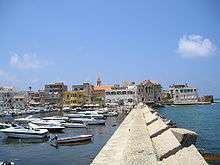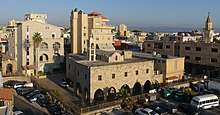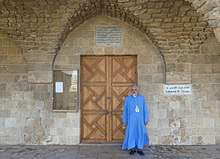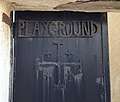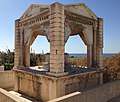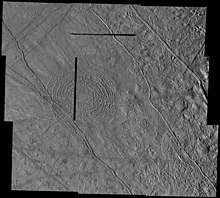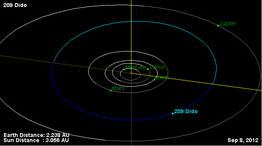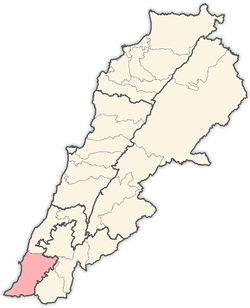Tyre, Lebanon
Tyre (Arabic: صور Ṣūr) is one of the oldest continually inhabited cities in the world,[1] though in medieval times for some centuries by just a tiny population. It was one of the earliest Phoenician metropolises and the legendary birthplace of Europa, her brothers Cadmus and Phoenix, as well as Carthage's founder Dido (Elissa). The city has many ancient sites, including the Tyre Hippodrome, and was added as a whole to UNESCO's list of World Heritage Sites in 1984.[2]
Tyre صور Tyr Sour (Lebanese French) | |
|---|---|
City | |
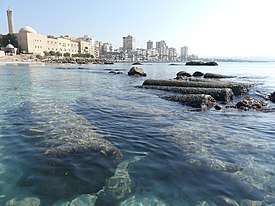 Submerged ancient columns with the skyline of the modern city in the background. | |
 Tyre | |
| Coordinates: 33°16′15″N 35°11′46″E | |
| Country | |
| Governorate | South Governorate |
| District | Tyre |
| Municipalities | Abbassieh, Ain Baal, Burj el-Shemali, Sour |
| Established | 2750 BCE |
| Area | |
| • City | 4 km2 (2 sq mi) |
| • Metro | 17 km2 (7 sq mi) |
| Population | |
| • City | 60,000 |
| • Metro | 174,000 |
| Demonym(s) | Tyrian |
| Time zone | UTC+2 (EET) |
| • Summer (DST) | UTC+3 (EEST) |
| Type | Cultural |
| Criteria | iii, vi |
| Designated | 1984 (8th session) |
| Reference no. | 299 |
| State Party | Lebanon |
The historian Ernest Renan noted:
One can call Tyre a city of ruins, built out of ruins.[3][4]
Today Tyre is the fifth largest city in Lebanon after Beirut, Tripoli, Aley and Sidon,[5] It is the capital of the Tyre District in the South Governorate. There were approximately 200,000 inhabitants in the Tyre urban area in 2016, including many refugees.[6]
Territory
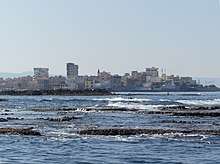
Tyre juts out from the coast of the Mediterranean Sea and is located about 80 km (50 mi) south of Beirut. It originally consisted of two distinct urban centres: Tyre itself, which was on an island just off shore, and the associated settlement of Ushu on the adjacent mainland, later called Palaetyrus, meaning "Old Tyre" in Ancient Greek.[7]
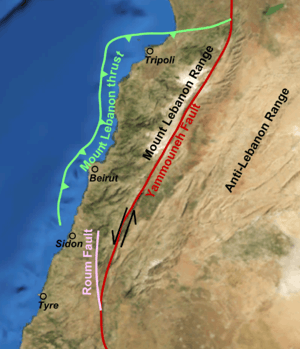
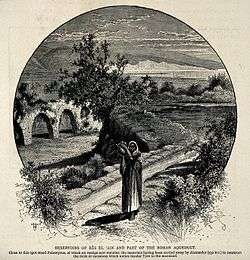
Throughout history from prehistoric times onwards, all settlements in the Tyre area profited from the abundance of fresh water supplies, especially from the nearby springs of Rashidieh and Ras Al Ain in the South. In addition there are the springs of Al Bagbog and Ain Ebreen in the North as well as the Litani River, also known as Alqasymieh.[8] The present city of Tyre covers a large part of the original island and has expanded onto and covers most of the causeway built by Alexander the Great in 332 BCE. This isthmus increased greatly in width over the centuries because of extensive silt depositions on either side. The part of the original island not covered by the modern city of Tyre is mostly of an archaeological site showcasing remains of the city from ancient times.
Four municipalities contribute to Tyre city's 16.7 km2 built-up area, though none are included in their entirety: Sour municipality contains the heart of the city, excluding the Natural and Coastal Reserve; Burj El Shimali to the East without unpopulated agricultural lands; Abbasiyet Sour to the North without agricultural lands and a dislocated village; and Ain Baal to the South-East, also without agricultural lands and dislocated villages. Tyre urban area lies on a fertile coastal plain, which explains for the fact that as of 2017 about 44% of its territory were used for intra-urban agriculture, while built-up land constituted over 40%.[6]
In terms of geomorphology and seismicity, Tyre is close to the Roum Fault and the Yammouneh Fault. Though it has suffered a number of devastating Earthquakes over the millennia, the threat level is considered to be low in most places and moderate in a few others. However, a tsunami following an earthquake and subsequent landslides and floods pose major natural risks to the Tyrian population.[6]
Vast reserves of natural gas are estimated to lie beneath Lebanese waters, much of it off Tyre's coast, but exploitation has been delayed by border disputes with Israel.[9]
Etymology
Early names of Tyre include Akkadian Ṣurru, Phoenician Ṣūr (𐤑𐤓), and Hebrew Tzór (צוֹר).[10] In Semitic languages, the name of the city means "rock"[11] after the rocky formation on which the town was originally built. The official name in modern Arabic is Ṣūr (صور).
The predominant form in Classical Greek was Týros (Τύρος), which was first seen in the works of Herodotus but may have been adopted considerably earlier.[10] It gave rise to Latin Tyrus, which entered English during the Middle English period as Tyre.[12] The demonym for Tyre is Tyrian, and the inhabitants are Tyrians.
Climate
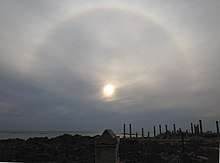
Tyre has a Hot-summer mediterranean climate (classified as Csa under the Köppen climate classification), characterized by six months of drought from May to October. On average, it has 300 days of sun a year and a yearly temperature of 20.8°C. The average maximum temperature reaches its highest at 30.8 °C in August and the average minimum temperature its lowest at 10 °C in January. On average, the mean annual precipitation reaches up to 645 mm. The temperature of the sea water reaches a minimum of 17 °C in February and a maximum of 32 °C in August. At a depth of 70 m it is constantly at 17–18 °C.[13]
Meanwhile, rising sea levels due to global warming threaten coastal erosion to Tyre's peninsula and bay areas.[14]
History
Founding Millenium (2750–1700 BCE)
onThrone_ViennaKunsthistorischesMuseum_cropped_FaustynaE.jpg)
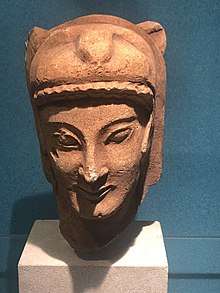
The Roman historian Justin wrote that the original founders arrived from the nearby Northern city of Sidon / Saida in the quest to establish a new harbour.[15][16] Herodotus, who visited Tyre around 450 BCE, wrote that according to the priests there, the city was founded around 2750 BCE[17] as a walled place upon the mainland,[18] now known as Paleotyre (Old Tyre). Archaeological evidence has corroborated this timing. Excavations have also found that there had already been some settlements around 2900 BCE,[17] but that they were abandoned.[15]
The Greek historian Eusebius recorded as the common myth that the deity Melqart built the city as a favour to the mermaid Tyros and named it after her.[19] Melqart - who got worshipped as a divine patron of Tyre for millennia - was called Melqart Heracles in Greek, but is not to be confused with the demigod Heracles (Hercules), hero of the 12 labors.[3] However, there are two other main founding legends:

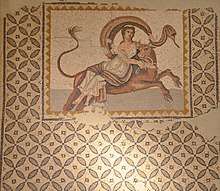
According to the first one, there were two brothers in primeval times – Usoos and Shamenrum – living on the seashore who separated after a fight. Usoos took a tree trunk and was the first to sail in it on the sea. He landed on an island and consecrated two columns there, one to fire and the other to the wind, thus founding Tyre which was called Ushu in Egypt and Mesopotomia. The second legend explains why Astarte as the goddess of fertility was worshipped in Tyre as well:[20]
"Originally the island was not attached to the sea floor, but rose and fell with the waves. An Olive tree of the goddess Ashtart rose there, protected by a curtain of Flames. A snake was wrapped around its trunk and an eagle was perched in it. It was predicted that the island would cease floating, when the bird was sacrificed to the gods. The god Melqart taught people how to build boats, then sailed to the island. The eagle offered itself, and Sur became attached to the sea floor. Since then, the gods have never stopped living there..."[3]
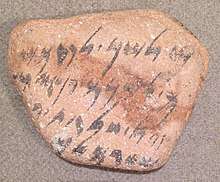
In Greek mythology, Zeus, the ruler of the gods, took the form of a bull to abduct the Tyrian princess Europa to Crete. There the couple had three sons – Minos,.Rhadamanthus, and Sarpedon, whom became kings of Crete and after their deaths the judges of the Underworld. The continent Europe is named after her.
Some sources go on to say that her brothers Cadmus and Cilix went to search for her, in vain. Instead, Cadmus became the founder and king of the Greek city of Thebes, who also introduced the Phoenician alphabet to the Hellenic world. Cilix fell in love during the quest and gave his name to Cilicia in Asia Minor. Their supposed third brother Phoenix became the eponym of Phoenicia.[21] In this way the Ancient Greek culture expressed its appreciation of the influence that the Phoenician civilisation had on their own.[3]
"Third and second millenia BC strata from Tyre [..] are buried so deeply under debris of later periods that its early history is somewhat obscure."[22]
The first known textual reference to Tyre comes from a curse text dated to the 19th century BCE.[23] In general, the first half of the second Millennium BCE in the Eastern Mediterranean was "a time of peaceful trade and Tyre probably shared in the commercial activity."[22]
Egyptian period (1700–1200 BCE)
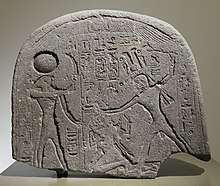
In the 17th century BCE, the settlement came under the supremacy of the Egyptian pharaohs. In the subsequent years it started benefitting from the protection by Egypt's Eighteenth Dynasty and prospered commercially.[16]
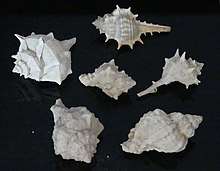
Archaeological evidence indicates that Tyre had already by the middle of the second millennium BCE established the industrial production of a rare and extraordinarily expensive sort of purple dye,[22] which was famous for its beauty and lightfast qualities.[24] It was exploited from the Murex trunculus and Murex brandaris shellfishes, known as Tyrian purple. The colour was, in ancient cultures, reserved for the use of royalty or at least the nobility.[25] In fact, the very word "Phoenician" is a Greek designation meaning "red" or "purple":[26]
"Tyrians brought their methods in the purple dye industry near to perfection. Their excellent technique of extraction and blending of dyes is the reason why Tyrian purple was so esteemed in the ancient world."[24]
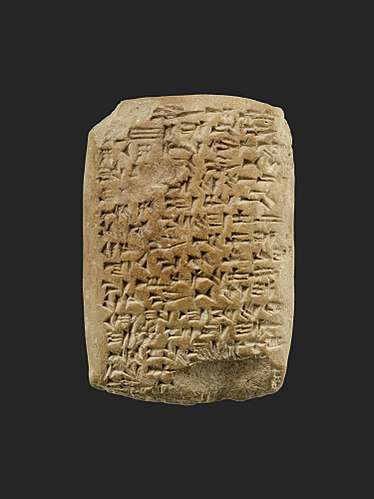
And:
"The Tyrians were extremely discreet about their industry to ensure absolute monopoly."[19]
According to mythology, deity Melqart was walking on the beach with the nymph Tyro, whom he courted, when his dog bit a mollusc and the sea snail's blood stained its mouth purple. Tyro desired from Melqart a dyed dress of the same colour and thus the manufacture was born.
However, the ancient author Strabo, who visited Tyre himself, recorded that the dye industry polluted the air so much that its stench made his stay in the city very unpleasant.[24] Experts have calculated that some 8.000 Murex had to be crushed to extract one gram of the dye,[19] which may have cost the equivalent of about twenty grams of gold.[23]
The first clear accounts of the city are given by the ten Amarna letters dated 1350 BCE from the Prince of Tyre, Abimilku, written to Akenaten. The subject is often water, wood and the Habiru overtaking the countryside of the mainland and how that affected the island-city.[17] Eventually, Egyptian forces defeated a Hittite army that besieged Tyre.[3]
While the city was originally called Melqart after the city-god, the name Tyre appears on monuments as early as 1300 BCE. Philo of Byblos (in Eusebius) quotes the antiquarian authority Sanchuniathon as stating that it was first occupied by Hypsuranius. Sanchuniathon's work is said to be dedicated to "Abibalus king of Berytus"—possibly the Abibaal,[27] who became the Phoenician king of Tyre towards the end of the 2nd millennium BCE.[16]
According to some sources, Tyrian sailors ventured to the British Isles and purchased tin there to produce bronze for arms and artefacts as early as in the 13th century BCE.[28][29]
In the 12th century BCE, Egypt's pharaohs gradually lost political control over the Levant,[15] though Egyptian art continued to influence Tyrian art for more than half a millennium.[30]
Independent Phoenician period (1200–868 BCE)
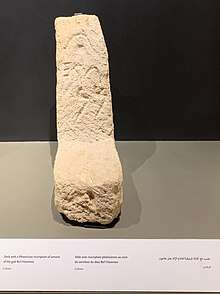
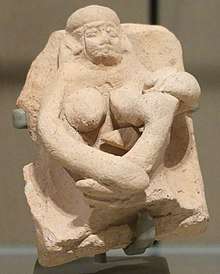
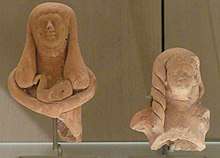

During the 11th century BCE the collection of maritime merchant-republic city-states constituting Phoenicia began a commercial expansion. Especially Tyre and Sidon benefited from the elimination of the former trade centers in Ugarit and Alalakh.[31] Hence, Phoenicia came to be characterized by outsiders and the Phoenicians as Sidonia or Tyria. Phoenicians and Canaanites alike were called Sidonians or Tyrians. Yet, such was Tyre's maritime dominance
"that the Mediterranean Sea became known as 'the Tyrian Sea".[16]
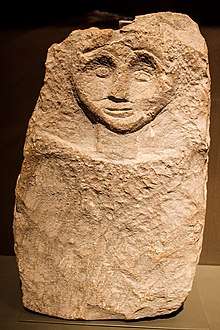
There is very little archaeological data from Tyre during this period of Iron Age II and thus it is not known how it imposed its hegemony on others.[32] However, it is widely assumed that it relied on trade as well as cultural exchange, rather than on military conquest. Most prominently, Tyre has been credited for spreading its alphabet and a Vigesimal numerical system.[29]
A decisive factor in this global rise were apparently the extraordinary skills by Tyrian scholars in astronomy to navigate their ships.[33] And as the space on the island city was limited, the inhabitants constructed multi-storey buildings. They thus acquired a reputation for being great masons and Engineers, also in metalworks and especially in shipbuilding.[3]
Written tradition has largely credited one individual with the strong growth of Tyre's prosperity from the 10th century BCE onwards: Hiram I, who succeeded his father Abibaal in 969 BCE. More than a millienium later, Flavius Josephus recorded the legend that Hiram expanded the urban territory by projects connecting two islands or Reefs to form a single island on which he had temples erected for Melqart, Astarte, and Ba'al Shamem.[32]
Beyond the borders of his kingdom, Hiram evidently forged close relations with the Hebrew kings David and Solomon. Reportedly, he sent cedar wood and skilled workers for the construction of the great Temple in Jerusalem.[31] Imports from Cyprus played an important part in this period.[32]
Furthermore, Hiram's regional cooperation as well as his fight against Philistine pirates[3] helped to develop trade with Arabia, and North and East Africa. Commerce from throughout the ancient world was gathered into the warehouses of Tyre, as its fortifications offered protection for valuable goods in storage or transit. And Tyrians not only settled in Memphis, south of the temple of Hephaestus in a district called the Tyrian Camp.[34] They also founded
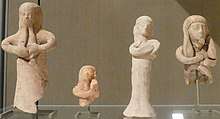
"colonies on the coasts and neighbouring islands of the Aegean Sea, in Greece, on the northern coast of Africa, at Carthage and other places, in Sicily and Corsica, in Spain at Tartessus and even beyond the pillars of Hercules at Gadeira (Cádiz)."[35]
However, after Hiram's reign of 34 years, several Tyrian kings were killed in succession fights:
"the king was chosen among the royal families and reigned for life. He was backed by a council of the elders (or magistrates,) and their decisions were controlled by the great merchant families."[3]
Neo-Assyrian period (868–612 BCE)
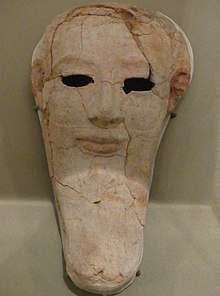
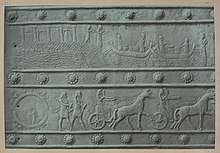
In the course of the 9th century BCE, the city remained close to the Israelites, as evident through the marriage of Jezebel from a royal Tyrian family with Ahab, King of Israel.[22]
However, Tyre started paying tribute to the Neo-Assyrians[16] who gradually established sovereignty over Phoenicia. It seems though that Tyre only made a nominal subjection and kept a large degree of independence, while benefiting in its commerce from the stability of a strong regional power.[31] Thus, Tyre itself remained one of the more powerful cities in the Eastern Mediterranean. One of its kings, the priest Ithobaal I (887–856 BCE), ruled as far north as Beirut, and part of Cyprus.[36]
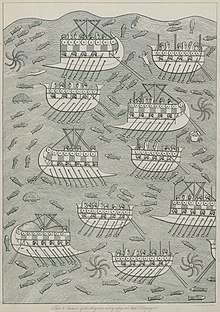
According to the myth, the Northern African city of Carthage (Qart-Hadašt = "New City") was founded in 814 BCE by Tyre's Princess Elissa, commonly known as Dido ("the wanderer"), who escaped after a power struggle with her brother Pygmalion with a fleet of ships.[16] She has also widely been credited as a pioneer mathematician in planimetrics: Legend has it that she purchased a large piece of land from the local Numid ruler, who granted her the size of land that an oxhide could cover, by having it cut into thin threads.[29] The ancient historians Josephus and Justin give elaborate accounts that a political conflict between the king and the priestly class was at the core of the break-up.[31]
In the course of the 8th century BCE, the Assyrian kings attempted to increase their sovereignty over Tyre.[3] Tiglath-Pileser III (744–727 BCE) demanded tribute from Hiram II and tried to prohibit trade between Tyre and settlements to the South.[23] His successor Shalmaneser V besieged the city with support from Phoenicians of the mainland from around 725 to 720 BCE, but was not able to take it.[37] Cyprus – on the other hand – liberated itself from Tyrian domination in 709 BCE.[33]
Sennacherib, who ruled the Neo-Assyrian kingdom from 705 to 681 BCE, failed to conquer Tyre in his military campaigns, but Tyrian king Luli lost control over the territories outside the city and was forced to flee. He was succeeded by pro-Assyrian monarchs and governors. Tyrian king Balu – or Baal I – reportedly assisted the Neo-Assyrian ruler Esarhaddon (680–669 BCE) in suppressing a Sidonian revolt and as an award gained control over much of the coast of Palestine. Yet, Balu apparently entered an alliance with Egyptian pharaoh Taharqa and was punished by Esarhaddon.[31]
Asurbanipal, Esarhaddon's successor from 669 to 631, reportedly destroyed the hinterland of Tyre, but because of its economic potential preserved the once again rebellious city which reactivated its trade and continued to prosper.[32]
As the Neo-Assyrian empire crumbled during the 7th century BCE, Tyre and the other Phoenician city-states not only enjoyed considerable independence, but also booming trade activities.:[22]
Independent and Neo-Babylonian period (612–539 BCE)
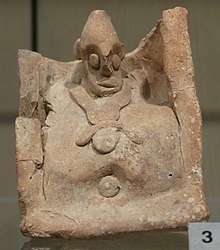
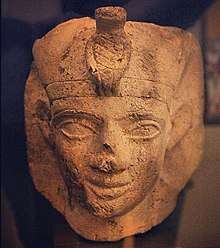
After the fall of the Assyrians in 612 BCE, Tyre and the other Phoenician city-states at first enjoyed another boom of its commerce without the burden of paying tributes. However, this period ended after a few years when Nebuchadnezzar II in 605 BCE started military campaigns in the Levant.[38] The Tyrian rulers allied themselves with Egypt, the kingdoms of Judah, Edom, and Moab as well as other Phoenician cities against the Neo-Babylonian ambitions for regional expansion. They succeeded in keeping their independence[22]
In 586 BCE, Nebuchadnezzar II started a siege of Tyre in that went on for thirteen years.[16] It failed, but the weakened city eventually conceded to pay a tribute.[37] Due to the long siege, Tyre had suffered economically, as its commercial activities were greatly damaged by the instability. Numismatic sources suggest that as a consequence Tyre lost grounds in its traditional rivalry with neighbouring Sidon,[38] which gained back the upper hand.[32]
At the same time, the influence of Egyptian art, which had remained "a cherished source of inspiration" even since the end of the Egyptian domination of the region in the 12th century BCE, finally diminished.[30]
Persian period (539–332 BCE)
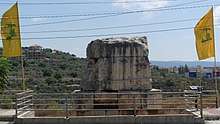
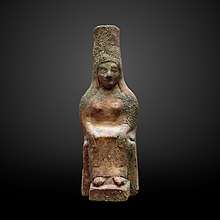
The Achaemenid Empire of the Persian king Cyrus the Great conquered the city in 539 B.C.[40] The Persians divided Phoenicia into four vassal kingdoms: Sidon, Tyre, Arwad, and Byblos. They prospered, furnishing fleets for Persian kings. However, when Cambyses II organised a war campaign against Carthage, Tyre refused to sail against its daughter city.[38]
Tyr_(Ph%C3%A9nicie_btv1b10322884x.jpg)
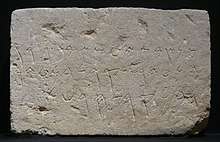
"Y'ms son of Gr', son of 'bdmlqrt, son of 'bd' son of Carthage"
Under Persian sovereignty, Tyre – like the other Phoenician city states – was at first allowed to keep its own kings,[22] but eventually the old system of royal families was abolished:
"a republic was instituted [..]: it was the government of the suffetes (judges), who remained in power for short mandates of 6 years."[3]
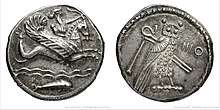
Tyre's economy continued to rely largely on the production of purple dye from Murex shellfish, which appeared on a silver coin of Tyre around 450–400 BCE,[24] when the city started minting its own currency. Other motives on coins included dolphins.[22]
Herodotus visited Tyre around 450 BCE and found the temple of Melqart
"richly adorned with a number of offerings, among which were two pillars, one of pure gold, the other of emerald, shining with great brilliancy at night"[41]
Some historians speculate that the emerald pillar was made of glass and lit up with a lamp.[3]
According to Roman historian Justin, an insurrection of slaves took place during the Persian period, which spared only the life of one slave-master named Straton – who was then selected by the former slaves to be the new king and established a dynasty.[38]
In 392 BCE Evagoras, Prince of Cyprus, started a revolt against the Persian rule with Athenian and Egyptian support. His forces took Tyre by assault – or by secret consent of the Tyrians. However, after ten years he terminated the rebellion and Tyre once again came under Persian control. It abstained from Sidon's insurgency in 352 BCE and profited commercially from the destruction of the neighbouring city.[38]
Hellenistic period (332–126 BCE)
.jpg)

After his decisive victory over the Persian king Darius III in 333 BCE and the conquest of Persia, Alexander the Great moved his armies south, exacting tribute from all of coastal Phoenicia's city-states. Tired of Persian repressions, they mostly welcomed the new ruler, yet Tyre resisted his ambitions:[26]
Tyre's king Azemilcus was at sea with the Persian fleet, when Alexander arrived in 332 BCE at the gates and proposed to sacrifice to Heracles in the city, which was home to the most ancient temple of Heracles. However, the Tyrian government refused this and instead suggested that Alexander sacrifice at another temple of Heracles on the mainland at Old Tyre.[42]
Angered by this rejection and the city's loyalty to Darius, Alexander started the Siege of Tyre despite its reputation as being impregnable.[16] However, the Macedonian conqueror succeeded after seven months by demolishing the old city on the mainland and using its stones to construct a causeway to the island:[7][43][19][40][44]
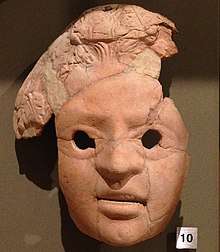
The tallest siege towers ever used in the history of war were moved via this man-made land bridge to overcome the walls of the city, which was running low on supplies. As Alexander's forces moved forward towards linking the fortified island with the mainland, the Tyrians evacuated their old men, women, and children to Carthage.[42] According to some historical sources, fellow Phoenician sailors from Sidon and Byblos, who had been forcefully recruited by Alexander, secretly helped many Tyrians to escape.[3]
Altogether some eight thousand Tyrians were reportedly killed during the siege, while Alexander's troops suffered only about four hundred casualties. After Alexander's victory he granted pardon to King Azemilcus and the chief magistrates. Yet according to Arrian, approximately 30,000 citizens were sold into slavery.[42]
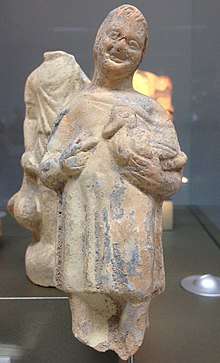
Alexander's legacy still lives on today, since Tyre has remained a peninsula instead of an island ever since.[16][19]
After Alexander's death in 323 BCE, his empire was divided and Phoenicia given to Laomedon of Mytilene. Ptolemy of Egypt soon annexed the region to his territory, but held it only for a few years.[42]
.jpg)
In 315 BCE, Alexander's former general Antigonus began his own siege of Tyre.[45] The city had recovered rapidly after Alexander's conquest,[42] but was still taken a year later.[46] Antigonus' son Demetrius ruled Phoenicia until 287 BCE, when it once again passed over to Ptolemy. It remained under the control of his successors for almost seventy years, until the Seleucids under Antiochus III invaded Phoenicia in 198 BCE.[42]
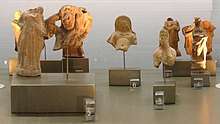
Despite those renewed devastations, Tyre regained its standing under Alexander's successors and as a privilege continued to mint its own silver coins.[47] While some of the trade in the Eastern Mediterranean diverted to Alexandria,[42] Tyre profited from the developing Silk Road commcerce.[29] In terms of culture,
"Tyre rapidly became Hellenized. Festivals in the Greek manner with offering of sacrifices, gymnastic contests, pageants and processions became part of the life of Tyre."[42]
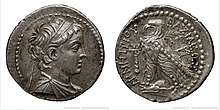
Some Arabian authors claim that Tyre was the birth-place of Euclid, the "Father of Geometry" (c. 325 B.C.). Other famous scholars from Tyre during the Hellenistic period included the philosophers Diodorus of Tyre, Antipater of Tyre, and Apollonius of Tyre.[29]
In 275 BCE, Tyre abandoned the concept of monarchy and instead became a republic.[33]
During the Punic Wars, Tyre sympathised with its former colony Carthage. Therefore, in 195 BCE, Hannibal, after his defeat by the Romans, escaped by ship to Tyre before moving on to Antioch.[42]
As the power of the Seleucid Empire started to crumble and Seleucid leaders engaged in dynastic fights, the royal rivals increasingly sought the support of Tyre. In this context, king Alexander Balas gave the city the right to offer asylum in 152.[48] Anyhow, the grip of the Seleucid rulers over Phoenicia increasingly weakened during the next quarter of a century:
Independence from Seleucid Empire (126–64 BCE)
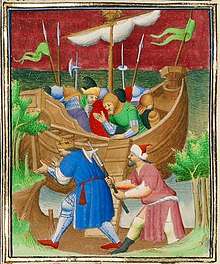
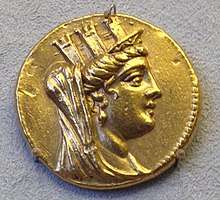
In 126 BCE, Tyre regained its independence from the fading Seleucid Empire.[49] One year later, the toppled Seleucid King Demetrius II Nicator fled to Tyre:
"Demetrius [..] was unpopular among his troops and subjects. His pride was his downfall, and he was deposed and imprisoned several times. Defeated and deserted by his wife and children, the king left Syria, taking a boat to Tyre. He planned to devote himself to the service of the god Hercules, who had a temple there. He arrived safely at the port, but the prefect of Tyre had him killed as he left his ship."[50]
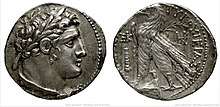
Also still in 125 BCE, Tyre adopted its own lunar-solar-hybrid calendar, which was used for 150 years.[29] The coins of independent Tyre became the standard currency in the eastern Mediterranean.[48]
After the start of the Mithridatic Wars between the outgoing Roman Republic and the Kingdom of Pontus in 88 BCE, Tyrian trade activities increasingly suffered though from the instability which persisted in the region.
Five years later the ruling classes of the Levant asked Tigranes II, king of Armenia, to become the ruler of Phoenicia in 83 BCE and restore order. Nevertheless, Tyre succeeded in preserving its independence.[51]
Following the 69 BCE defeat of Tigranes' army in the Third Mithridatic War against Roman troops led by Lucius Licinius Lucullus,[42] Antiochus XIII Asiaticus nominally restored the Seleucid rule over the region.[51] However, as a client king thanks to Lucullus' approval he apparently did not wield any actual power over Tyre. Lucullus' successor Pompey had Antiochus assassinated and thus ended the Seleucid dynasty for good.
Roman period (64 BCE – 395 CE)

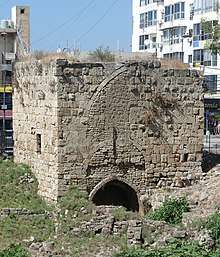
In 64 BCE the area of "Syria" finally became a province of the late Roman Republic, which was itself about to become the Roman Empire.[52] Tyre was allowed to keep much of its independence as a "civitas foederata".[53] A decree found at Tyre implies that Marcus Aemilius Scaurus – Pompey's deputy in Syria – played the key role in granting Tyre the privileged status of remaining a free city. Scaurus did apparently so "against a certain payment".[54]
Thus, Tyre continued to maintain much of its commercial importance. Apart from purple dye, the production of linen became a main industry in the city[54] as well as garum fish sauce, "comparable to caviar in our days".[55]
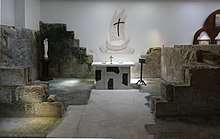
Its geographical location made Tyre the "natural" port of Damascus, to which it was linked through a road during the Roman period,[56] and an important meeting point of the Silk Road.[29] Thus the Tyrians extended their areas of hegemony over the adjoining regions, such as in northern Palestine region, settling in cities such as Kedesh,[57] Mount Carmel[58] and north of Baca.[59]
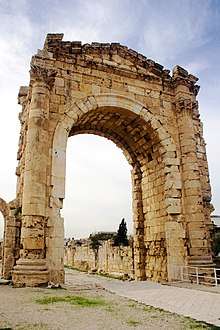
It is stated in the New Testament that Jesus visited the region of Tyre. Some sources tell that he drank water with John sitting on a rock by the spring of Ain Sur (Source of Tyre), which is also known as Ain Hiram, named after the Phoenician king.[60] According to the bible, Jesus healed a Gentile (Matthew 15:21; Mark 7:24) and from this region many came forth to hear him preaching (Mark 3:8; Gospel of Luke 6:17, Matthew 11:21–23). Apparently, some of those who followed him hailed from Tyre.[54]
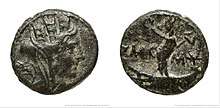
A Christian congregation was founded in Tyre soon after the death of St. Stephen. Paul the Apostle, on his return from his third missionary journey, spent a week in conversation with the disciples there.[54] According to Irenaeus of Lyon in On the Detection and Overthrow of the So-Called Gnosis, the female companion of Simon Magus came from here.
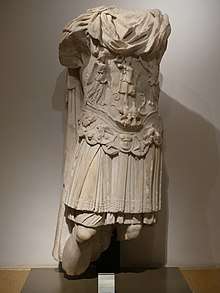
In the early second century CE, Emperor Hadrian, who visited the cities of the East around 130 CE, conferred the title of Metropolis on Tyre: "great city" mother of other cities. This status was of "utmost importance",[61] as it settled the ancient rivalry with Sidon in Tyre's favour - for the time being.[54] According to the Suda encyclopedia, the orator Paulus of Tyre, who served as an ambassador to the Imperial court in Rome, played the main role in securing this prestigious title.[61] Hadrian also allowed Tyre to mint its own coins.[3]
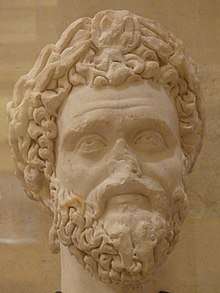
Subsequently, the famous Triumphal Arch and the Tyre Hippodrome, one of the largest hippodromes in the world (480m long and 160m wide), were constructed.[62] The amphitheater for the horse-racetrack could host some 30.000 spectators. An aqueduct of about 5 km length was built to supply the city with water from the Ras Al Ain basins in the South.[19]
In the middle of the second century, the cartographer Marinus of Tyre became the founder of mathematical geography, paving the way for Claudius Ptolemy's Geography. Other famous scholars from Roman Tyre include the pre-eminent jurist Ulpian, as well as the philosophers Maximus of Tyre, who was one of the tutors of emperor Marcus Aurelius,[3] and Porphyry of Tyre.[29]
When in 193 CE Septimius Severus and Pescennius Niger competed against each other for the throne of Rome, Tyre sided with Severus, who was born in Tyre's former colony Leptis Magna.[63] Niger's troops in retaliation looted Tyre and killed many of its inhabitants. Yet after the defeat of his rival, Severus rewarded Tyre's loyalty with the status of a Colony, which enabled the city to regain some of its wealth[54] as it granted Tyrians Roman citizenship, with the same rights as Romans themselves.[3] In 198 CE Tyre became the capital of the province Syria Phoenice.[33]
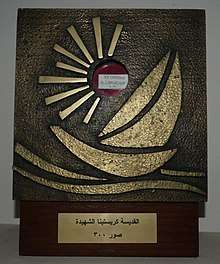
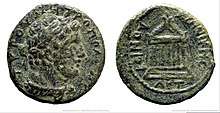
During the third century CE the Heraclia games – dedicated to Melqart-Heracles (not to be confused with the demigod Heracles, hero of the 12 labors)[3] – were held in the Tyrian hippodrome every four years.[54]
Faced with the growth of Christianity in the third century, the Roman authorities supported paganism and encouraged the practise of Tyre's ancient cults, especially the worshipping of Melqart. When Emperor Decius ordered a general prosecution of Christians in 250–251 CE, followers of Jesus in Tyre suffered as well. According to the ancient bishop and historian Eusebius, the Christian scholar Origen died in Tyre around 253 CE due to injuries from torture.[54]

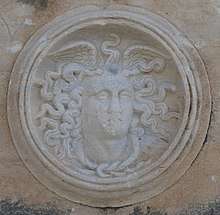
In the wake of the Diocletianic Persecution as the last and most severe persecution of Christians in the Roman Empire, followers of Jesus in Tyre were harshly affected as well. According to religious accounts, one of the most prominent martyrs was Saint Christina, the daughter of the city's governor, who was executed around 300 CE, after her own father had her tortured. In 304 CE, some 500 Christians were reportedly persecuted, tortured and killed in Tyre.[64] Around the same time, a heavy earthquake struck the city once again, causing death and destruction.[65]
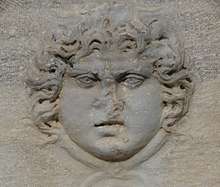
However, less than a decade later "the young, and very rich" Bishop Paulinus had a basilica constructed upon the ruins of a demolished church,[66] which in turn had probably been built upon the ruins of the ancient Temple of Melqart. Reportedly, Origen was buried behind the altar. In 315 CE, just two years after the Edict of Milan about the benevolent treatment of Christians, the Cathedral was inaugurated by Bishop Eusebius, who recorded his speech and thus a detailed account of the site in his writings. Not only is this considered the oldest description of a church, but:
"The Cathedral of Paulinus is considered the oldest in Church history".[19]
Subsequently, Tyre became caput et metropolis, "head and capital" of the churches of the region.[3]
Saint Frumentius – who was born around that time in Tyre – became the first bishop of the Ethiopian Orthodox Tewahedo Church, after he and his brother Edesius sailed with an uncle to the Red Sea and were shipwrecked on the Eritrean coast. While Edesius returned to Tyre to become a priest, Frumentius has been credited with bringing Christianity to the Kingdom of Aksum.[3]
Byzantine period (395–640)
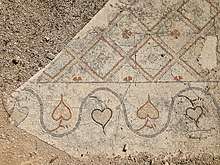
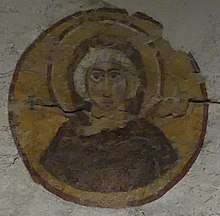
In 395 Tyre became part of the Byzantine Empire and continued to flourish. Its traditional industries remained prominent during this period[16] but the city prospered most from Tyre's strategic position on the Silk Road,[29] which also allowed it to profit from establishing silk production after the secret procedures had been smuggled out of China.[3]
The necropolis on mainland Tyre with more than three hundred sarcophagi from the Roman and Byzantine periods grew to be one of the largest in the world. A main road of some 400m length and 4,5m width paved with limestone was constructed there during Byzantine times.[19] Close by, two churches with marble decorations were built in the 5th and early 6th century CE respectively, when construction in ancient Tyre reached its zenith.[67]
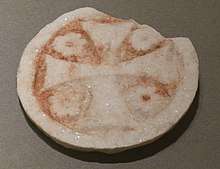
During the entire period of Byzantine rule, the archbishopric of Tyre had primacy over all the bishops of the Levant. Yet, while Christianity was the main religion, some people reportedly continued to worship the Phoenician deities, especially Melqart.[3]
_(27836777529).jpg)
Over the course of the 6th century CE, starting in 502,[65] a series of earthquakes shattered the city and left it diminished. The worst one was the 551 Beirut earthquake[3] which was accompanied by a Tsunami:[65] it destroyed the Great Triumphal Arch on the mainland,[47] while the Egyptian harbour and parts of the suburb on the Southern part of the peninsula were submerged in the sea.[67]
In addition, the city and its population increasingly suffered during the 6th century from the political chaos that ensued when the Byzantine empire was torn apart by wars.[3]
The city remained under Byzantine control until it was captured by the Sassanian shah Khosrow II at the turn from the 6th to the 7th century CE, and then briefly regained until the Muslim conquest of the Levant, when in 640 it was taken by the Arab forces of the Rashidun Caliphate.[29]
Early Muslim period (640–1124)
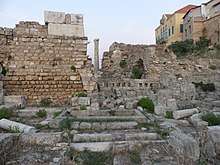
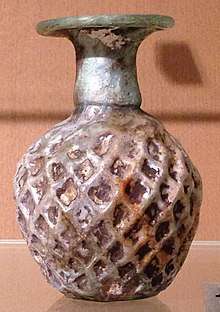
As the bearers of Islam restored peace and order, Tyre soon prospered again and continued to do so during half a millennium of Caliphate rule[47] This was despite the fact that the city stayed reduced to a part of the old island after the devastations of the earthquakes in the 6th century.[67]
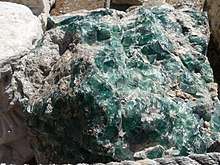
In the late 640s, the caliph's governor Muawiyah launched his naval invasions of Cyprus from Tyre,[16] but the Rashidun period only lasted until 661.[29] It was followed by the Umayyad Caliphate (until 750) and the Abbasid Caliphate. Tyre became a cultural center of the Arab world which hosted many well-know scholars and artists.[29]
In the course of the centuries, Islam spread and Arabic became the language of administration instead of Greek,[29][26] though some people reportedly continued to worship the ancient cult of Melqart.[3] As in previous centuries, there were also Jewish residents, some of whom engaged in trade.[68]

During the Ismaili Shia Fatimid Caliphate, a Grand Mosque was constructed[60] in the place that probably had been the location of the Temple of Melqart before.[19] Meanwhile, Tyre's economy remained part of the Silk Road[29] and continued its traditional industries of purple dye and glass production.[3] Excavation at the Al Mina site have revealed glass furnaces from the early Islamic period that had the capacity to produce in a single-melt session over fifty tonnes of glass. In addition, sugar production from cane fields around the city became another main business.[68]
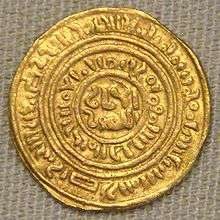
In the Revolt of Tyre (996–998), the populace rose against Fatimid rule, led by an ordinary sailor named 'Allaqa. However, the caliph al-Hakim bi-Amr Allah sent his army and navy to blockade and retake the city. A Byzantine squadron's attempt to reinforce the defenders was repulsed with heavy losses. After two years of siege, the Fatimids looted the city and massacred the insurgents.[69]
In 1086 it fell into the hands of the Seljuks who lost it in 1089 to the Fatimids. By that time, some estimates put the number of inhabitants at around 20,000.[70] The majority of that population were apparently Shiites.[71]
Ten years later, Tyre avoided being attacked by paying tribute to the Crusaders who marched on Jerusalem. In late 1111, King Baldwin I of Jerusalem laid siege on the city,[72] which in response put itself under the protection of the Seljuk military leader Toghtekin. Supported by Fatimid forces, he intervened and forced the Franks to raise the siege in April 1112, after about 2.000 of Baldwin's troops had been killed.[16] A decade later, the Fatimids sold Tyre to Toghtekin who installed a garrison there.
Crusader period (1124–1291)
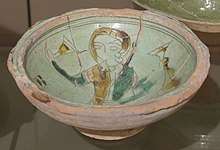
On 7 July 1124, in the aftermath of the First Crusade, Tyre was the last city to be eventually taken by the Christian warriors – a Frankish army on the coast and a fleet of the Venetian Crusade from the sea side[72] – following a siege of five and a half months[16] that caused great suffering from hunger to the population.[72] Eventually, Seljuk leader Toghtekin negotiated an agreement for surrender with the authorities of the Latin Kingdom of Jerusalem
"on condition that those citizens who wished to be allowed to depart freely with their wives and children and all their substance, while those who preferred to remain at Tyre should be granted permission to do so and their homes and possessions guaranteed them."[73]
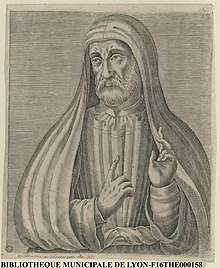
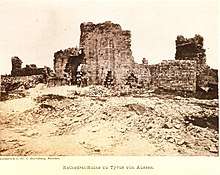
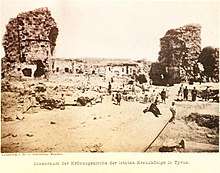
Under its new rulers, Tyre and its countryside were divided into three parts in accordance with the Pactum Warmundi: two-thirds to the royal domain of Baldwin and one third as autonomous trading colonies for the Italian merchant cities: mainly to the Doge of Venice, who had a particular interest in supplying silica sands to the glassmakers of Venice[3] and in the sugar-cane plantations on the mainland.[74] In addition, there were a Genoese quarter,[70] and a Pisan neighbourhood.[72]
In 1127, Tyre was reportedly shaken by a heavy earthquake that caused many casualties.[72] It was followed by the 1157 Hama earthquake and the 1170 Syria earthquake. Although the loss of lives were reportedly small, some towers were damaged in the latter.[65]
Nevertheless, Tyre became one of the most important cities of the Kingdom of Jerusalem, as it opened the Silk Road to the Western kingdoms.[29] There was much commercial activity, especially glassware by the Jewish community, Sendal silk cloth, purple dye,[75] and sugar factories.[72] The new rulers also continued to mint "Tyre Dinars" that imitated the Fatimid coins.[76]
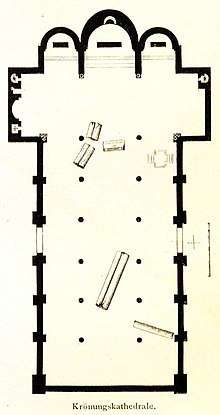
The city was the see of a Roman Catholic archbishopric, whose archbishop was a suffragan of the Latin Patriarch of Jerusalem; its archbishops often acceded to the Patriarchate. The most notable of the Latin archbishops was the historian William of Tyre, who held the office from 1175 to 1184 and was also chancellor of the kingdom.[72]
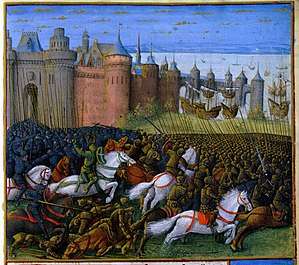
While the Venetians quickly constructed the church of San Marco in their quarter and the Pisans built a church of San Pietro, the Saint Mark Cathedral of Tyre was erected upon the ruins of the Fatimid Grand Mosque[60] – which in turn had probably been constructed upon or at least the near the ruins of several iterations of Christian churches, and on the lowest level the ancient Temple of Melqart.[19] Despite this Christian domination, there was peaceful coexistence of religion: the Jewish community was estimated to number some 500 members,[70] many of whom were arabised.[77] Muslims continued to follow Islam, most prominently Um Ali Taqiyya, "one of the first Tyrian women who excelled in poetry and literature".[29] There were reportedly even still followers of the ancient religion of Melqart.[3] Contemporary estimates put the number of residents at around 25,000.[70]
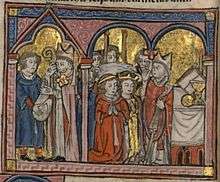
After the loss of Jerusalem to Saladin in 1187, many crusaders escaped to Tyre with its strong fortifications: "The refugee barons of Palestine were now crowded in the city." Saladin put on the Siege of Tyre twice but gave up on New Year's Day 1188. Thanks to Frankish military and naval reinforcements, Conrad of Montferrat was able to organise an effective defense.[72]
Subsequently, Tyre's Cathedral became the traditional coronation place for the kings of Jerusalem and a venue for royal marriages.[19] While the Venetian influence was considerably weakened, their privileges infringed and Fiefs conifiscated, the position of Genoa and Pisa got strengthened as a reward for their support to Conrad.[74]
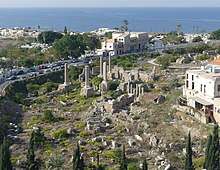

When the Holy Roman Emperor Frederick I, also known as Frederick Barbarossa, drowned in 1190 in Asia Minor while leading an army in the Third Crusade, his bones were reportedly buried in the cathedral of Tyre.[78]
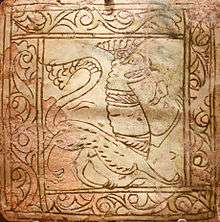
Tyre remained for four years the only city of the Latin Kingdom under Frankish rule[74] - until the reconquest of Acre by Richard I of England on 12 July 1191, when the seat of the kingdom moved there.
On 27 April 1192, Conrad of Montferrat – who had been elected as king of Jerusalem just days before – was assassinated at Tyre by members of the Order of Assassins.[72]
Ten years later, the 1202 Syria earthquake caused very severe damages in Tyre.[72] Most of the towers and walls collapsed[79] and many human lives were lost.[65]
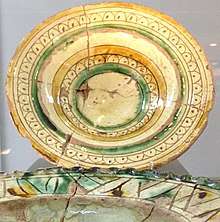
In 1210, John of Brienne and his wife Maria of Montferrat were crowned King and Queen of Jerusalem in Tyre.[80]
After the Sixth Crusade, from 1231 onwards, the forces of Riccardo Filangieri occupied Tyre on behalf of Emperor Frederick II of Hohenstaufen for more than a decade. They were defeated in 1242 by the baronial party and its Venetian allies. Balian of Ibelin, Lord of Beirut, was appointed royal custodian of Tyre on behalf of Queen Alice of Cyprus. In 1246, King Henry I of Cyprus separated Tyre from the royal domain and assigned the Lordship of Tyre to Philip of Montfort.[74]
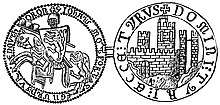
In 1257 – one year after the beginning of the War of Saint Sabas between Genoa and Venice over control of Acre – Philip expelled the Venetians from the one third of the city that had been conceded to them more than a century earlier, though its quasi-exterritorial status was eroded already from early on.[75]
In May 1269, the Mamluk Sultan Baibars led an abortive raid upon Tyre after failed negotiations about a truce.[81] In September of that year, Hugh III of Cyprus was crowned King of Jerusalem in Tyre.[72] A year later, Philip was killed by an assassin, apparently in the employ of Baibars, and succeeded by his eldest son, John of Montfort. He entered a treaty with Baibars, transferring control over five villages to him. In 1277, he also restored Venetian privileges.[74]
After John's death in 1283 and the death of his brother Humphrey of Montfort in 1284, John's widow Margaret of Antioch-Lusignan – the sister of Hugh III – became the Lady of Tyre. Two years later she entered into a land control treaty with Baibars' successor Al-Mansur Qalawun.[81]
In 1291, Margaret ceded the Lordship of Tyre to her nephew Amalric of Lusignan and retired to the monastery of Our Lady of Tyre in Nicosia.
Mamluk period (1291–1516)
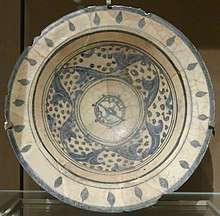
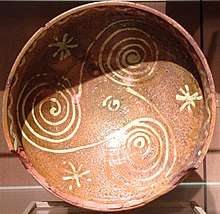
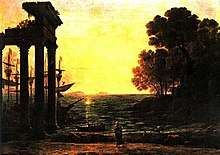
In the same year of Dame Margaret's retirement – in 1291 – Tyre was again taken, this time by the Mamluk Sultanate's army of Al-Ashraf Khalil.[16] Reportedly, the whole population had evacuated the city by ship on the day that Acre as one of the last Crusader strongholds had fallen after two months of siege, so that the Mamluks found Tyre mostly empty.[82] Amalric, the last Lord of Tyre, escaped as well.
Sultan Khalil had all fortifications demolished to prevent the Franks from re-entrenching.[70] The Crusader cathedral, which had been damaged before by the 1202 earthquake, got further destructed by the conquerors as well.[78] The city was subsequently governed from Acre and thus became part of Palestine.[83]

The traditional pottery and glassware industry in Tyre continued its production of artful objects during the early Mamluk period.[26] However, the purple dye industry, which had been a major source of income for the city throughout its previous history, did not get started again, since new dyes entered the market that were cheaper, like for example Turkey red.[24]
While the sultanate was rocked by factional struggles after Khalils death in 1293 and political instability, Tyre – "the London"[82] or "New York City"[28] of the Old World – lost its importance and "sank into obsurity." When the Moroccan explorer Ibn Batutah visited Tyre in 1355, he found it a mass of ruins.[84] Many stones were taken to neighbouring cities like Sidon, Acre, Beirut, and Jaffa[82] as building materials.[17]
In 1610, the English traveller George Sandys noted about his visit to Tyre:
"This once famous Tyre is now no other than a heap of ruins; yet have they a reverent respect: and do instruct the pensive beholder with their exemplary frailty."[82]
Ottoman period (1516–1918)
Maan clan rule
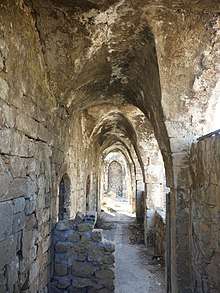
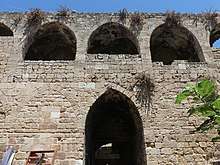
The Ottoman Empire conquered the Levant in 1516,[16] yet Tyre remained untouched for another ninety years until the beginning of the 17th century, when the Ottoman leadership at the Sublime Porte appointed the Druze leader Fakhreddine II of the Maan family as Emir to administer Jabal Amel (modern-day South Lebanon) and Galilee in addition to the districts of Beirut and Sidon.[85]
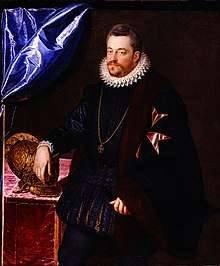
One of his projects in Tyre was the construction of a residence for his brother, Prince Younis Al-Maani. Its foundations were evidently built upon ruins from the Crusader period. The ruins of the palace are still standing in the centre of today's Souk marketplace area and are known as Khan Abdo El-Ashqar,[86] or Khan Al-Askar[60][87] as well as Khan Sour.
Fakhreddine also encouraged Shiites and Christians to settle to the East of Tyre to secure the road to Damascus. He thus laid the foundation of modern Tyre demographics as many of those settlers – or their descendants respectively – later moved to the town.[71] Those development efforts were over-shadowed though when the Emir aspired to establish an independent state that is widely viewed as the earliest vision of Lebanon as a country:
-2.png)
"In 1608, Fakhr al-Din signed a treaty with Ferdinand, the Medici grand duke of Tuscany, which included a secret article clearly directed against the Porte.[88]
At the core of this alliance with Florence was the plan to rebuild the harbour for naval support.[60] In this context, he converted the remains of Tyre's former Crusader's Cathedral in 1610 into a military fortress.[89] Notwithstanding, he was chased out by the Turkish army and went into exile in Tuscany.[88]
In 1618, Fakhreddine (also spelled Fakhr-al-Din) returned to the Levant thanks to the removal of some of his enemies within the Ottoman regime. He then also entertained poitical relations with France: after a diplomatic mission sent by King Louis XIII and Cardinal Richelieu[90] the Maani palace in Tyre "became the property of the Franciscan fathers."[60] By 1631, Fakhreddine dominated most of Syria, Lebanon and Palestine, but the Maan era ended when Sultan Murad IV had the Druze Emir executed together with one or two of his sons in 1635 for his political ambitions.[91]
Rise and rivalry of the feudal Zu'ama

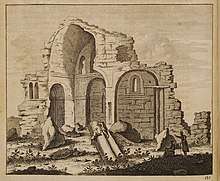
In the following decades, Ali al-Saghir – a leader of the discriminated Metwali, the Shia Muslims of what is now Lebanon – established a dynasty[92] that dominated the area of Jabal Amel for almost three centuries until the mid-twentieth century.[85] The scions of its al-As'ad clan have continued to play a political role even into the 21st century, though of lately a rather peripheral one.[93]
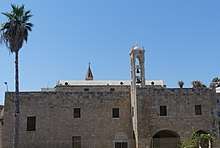
In 1697 the English scholar Henry Maundrell visited Tyre and found only a "few" inhabitants, who mainly subsisted upon fishing.[56] Their situation was made even worse by Tuscan, Maltese and Monégasque pirates, who would sometimes raid the Tyrian coast, as well as by heavy taxation. The hinterland of Tyre "was generally seen as a lawless country where criminals would flee to seek refuge with the Shiites."[92]
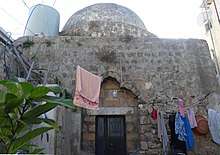

Under these conditions, Tyre also became – at least nominally – the center of the schism within the Greek Orthodox Church of Antioch:[94] its archbishop of Tyre and Sidon – Euthymios Saif – had been working on regaining communion with the Holy See in Rome at least since 1683. In 1701, the Congretation Propaganda Fide appointed him by secret decree to be the Apostolic Administrator of the Melkites.[95][96]
In 1724, one year after Saifi's death, his nephew and student Seraphim Tanas was elected as Patriarch Cyril VI of Antioch. He quickly affirmed the union with Rome and thereby the separation from the Greek Orthodox Church.[97] However, only a handful of Christian families actually lived in Tyre at the time. Church services were held in the ruins of Saint Thomas church near the remains of the Crusaders Cathedral.[72]
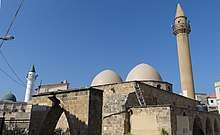
Around 1750, Jabal Amel's ruler from the Shiite dynasty of Ali al-Saghir (see above),[85] Sheikh Nasif al-Nassar, initiated a number of construction projects to attract new inhabitants to the almost deserted town.[91] His representative in Tyre was the "tax-farmer and effective governor" Sheikh Kaplan Hasan. The main trade partners became French merchants, though both Hasan and Al-Nassar at times clashed with French authorities about the conditions of the commerce.[92]
Amongst Al-Nassar's projects was a marketplace. While the former Maani palace was turned into a military garrison,[86] Al-Nassar commissioned the Serail at the Northern port as his own headquarters, which nowadays houses the police HQ. The military Al Mobarakee Tower from the Al-Nassar era is still well-preserved, too.[60][87]
.jpg)
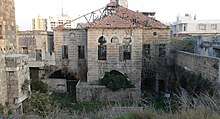
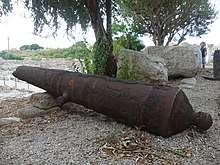
In 1752, construction of the Melkite cathedral of Saint Thomas was started thanks to donations from a rich merchant, George Mashakka – also spelled Jirjis Mishaqa[98] - in a place that had already housed a church during the Crusader period in the 12th century.[60] The silk[86] and tobacco trader had been persuaded by Al-Nassar to move from Sidon to Tyre. Numerous Greek Catholic families followed him there. Mashakka also contributed considerably to the construction of a great mosque,[72] which is nowadays known as the Old Mosque.[86] However, around the same time the resurgence of Tyre suffered some backlashes: the devastating Near East earthquakes of 1759 destroyed parts of the town and killed an unknown number of people as well.[28] In 1781, Al-Nassar was killed in a power-struggle with the Ottoman governor of Sidon, Ahmad Pasha al-Jazzar, who had the Shiite population decimated in brutal purges. Thus, the Shiite autonomy in Jabal Amel ended for a quarter century.[85]
At the beginning of the 19th century though, another boom period set in: in 1810 a Caravanserai was constructed near the former palace of Emir Younes Maani and the marketplace area: Khan Rabu.[60] A Khan was "traditionally a large rectangular courtyard with a central fountain, surrounded by covered galleries".[99] Khan Rabu (also transliterated Ribu) soon became an important commercial center.[60] A few years later, the former Maani Palace and military garrison was transformed into a Caravanserai Khan as well.[60][87]
In 1829, another Town of Tyre was formed: in the United States of America. An early settler – Jason Smith – was "presumably" inspired by ancient Tyre when he chose the name, according to the Town Historian in the northern Seneca County of the state of New York. The town – like its Mediterranean namesake – featured an aqueduct, a part of which still exists.[100] The Hiram Lay Cobblestone Farmhouse, which is on the National Register of Historic Places, was apparently named after the Phoenician king of Tyre.
Egyptian Occupation (1831–1839)
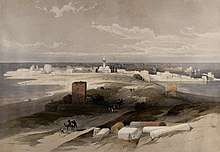
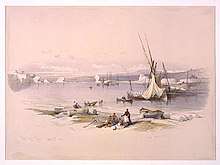
In December 1831 Tyre fell under the rule of Mehmet Ali Pasha of Egypt, after an army led by his son Ibrahim Pasha had entered Jaffa and Haifa without resistance.[101] Subsequently, a number of Egyptians settled in the city, which still today features a "Street of the Egyptians" in its old town.[91] Then, the Galilee earthquake of 1837 brought misery and destruction over Tyre:
"The wind had risen to a cold, cross gale, which howled through shattered walls and broken windows its doleful wail over ruined Tyre. The people were sleeping in boats drawn up on shore, and in tents beside them, while half-suspended shutters and doors unhinged were creaking and langing in dreadful concert."[102]
Two years later, Shiite forces under Hamad al-Mahmud from the Ali al-Saghir dynasty (see above) rebelled against the occupation.[85] They were supported by the British Empire and Austria-Hungary: Tyre was captured on 24 September 1839 after allied naval bombardments.[103]
French influence zone (from mid-19th c. on)
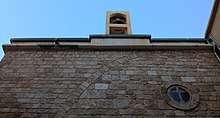
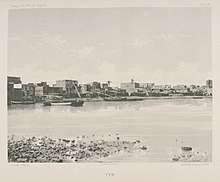
For their fight against the Egyptian invaders, Al-Mahmud and his successor Ali al-As'ad – a relative – were rewarded by the Ottoman rulers with the restoration of Shiite autonomy in Jabal Amel.[85] However, in Tyre it was the Mamlouk family that gained a dominant position. Its head Jussuf Aga Ibn Mamluk was reportedly a son of the Anti-Shiite Jazzar Pasha (see above).[89]
Meanwhile, the Egyptian occupation had opened the door for European intervention in Ottoman affairs through various Lebanese communities. Thus France under Napoleon III and its allied Maronite leaders increased their influence across Lebanon from the mid-19th century onwards.[85]
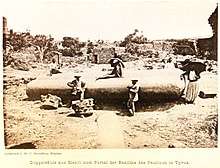
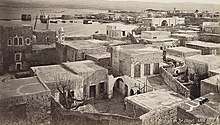
When the Emperor of the French thus sent an expeditionary corps of some 7,000 troops to Beirut during the 1860 Mount Lebanon civil war between Druze and Maronite groups, he also commissioned first archaeological excavations in Tyre that were undertaken by Ernest Renan. After his departure irregular digging activities disturbed the historical sites.[17]
In the same year, the Greek-Orthodox church of Saint Thomas was consecrated near the Greek-Catholic Saint Thomas Cathedral. Around the same time, the Latin-Catholic church of the Holy Land was established by the Franciscan order.[87][60]
In 1865, Jabal Amel's ruler Ali al-As'ad died after a power struggle with his cousin Thamir al-Husain.[85]
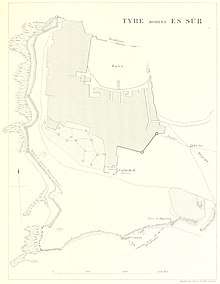
.jpg)
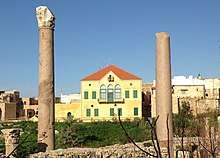
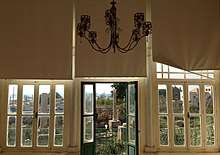
In 1874, the Bavarian historian and politician Johann Nepomuk Sepp led a mission to Tyre to search for the bones of Frederick Barbarossa. The expedition had the approval of Otto von Bismarck, Chancellor of the German Empire, and openly pursued ambitions to establish a German colony. While Sepp and his team failed to discover Barbarossa's remains, they did excavate the ruins of the Crusader cathedral and took a number of archaeological findings to Berlin where they were exhibited.[78] For their excavations, Sepp and his team had some 120 people evicted, though with some compensation, with the support of local authorities.[89]
According to Sepp, Tyre had some 5,000 inhabitants in 1874.[89] A traveller from the US, who visited Tyre around the same time put the number at maximum 4,000, about half of them Shiites and half Catholic Christians, with "a sprinkling of Protestants."[28] In 1882, the Sisters of Saint Joseph of the Apparition founded a school at the Western sea side of the Christian quarter.
-LCCN2002725061.jpg)
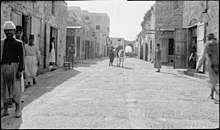
Meanwhile, the 1858 Ottoman Land reforms led to the accumulated ownership of large tracts of land by a few families upon the expense of the peasants. While the Al-As'ad descendants of the rural Ali al-Saghir dynasty expanded their fief holdings as the provincial leaders in Jabal Amel, another power player rose from the urban class of the mercantilist notables ("Wujaha' ") to the rank of Zu'ama (feudal landlords) in Tyre:[104]
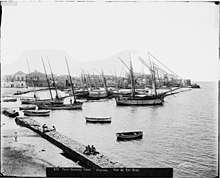
The grain merchant al-Khalil family would go on to play a dominant role in the city for more than a century.[83] It was reportedly a branch of one of the main dynasties in Jabal Amel, the Zayn family in Nabatieh,[105] and connected to another feudal clan, the Sidon-based Osseirans, by marriage:[83]
"According to one source, they were supported by the ulama in their climb to prominence in an effort to undermine the unpopular dominance of the Sunni al-Mamluk family of that city."[105]
It was
"a 'dark age' of ignorance and feudalism; it was a time when the masses, al ama, were terrified of their masters and landlords, of the Ottoman Officialdom, a time when the flock [..] took life as 'slavery and obedience."[106]
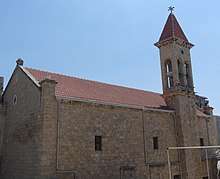
As a result of this mass-impoverishment, many inhabitants of Tyre and Jabal Amil emigrated in the 1880s to West Africa.[107]
In 1906, construction of the Maronite cathedral of "Our Lady of the Seas" near the modern harbour was finished. It was built on the foundations of an older church.[60]
The 1908 Young Turk Revolution and its call for elections to an Ottoman parliament triggered a power-struggle in Jabal Amel: on the one hand side Rida al-Sulh of a Sunni dynasty from Sidon, which had sidelined the Shia Al-As'ad clan of the Ali al-Saghir dynasty (see above) in the coastal region with support from leading Shiite families like the al-Khalil clan in Tyre. His opponent was Kamil Al-As'ad from the Ali al-Saghir dynasty that still dominated the hinterland.[85] The latter won that round of the power-strugggle, but the political rivalry between al-Khalil and Al-As'ad would go on to be a main feature of Lebanese Shia politics for the next sixty years.[83]
By that time, Tyre had a population of about 2,800 Shi'ites, 2,700 Christians and 500 Sunnis. In the district of Tyre there were altogether some 40,000 Shi'ites and 8,000 Christians.[85]
World War I
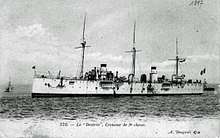
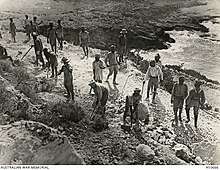
At the beginning of the First World War in 1914, many Shiites in Jabal Amel were conscripted and thus had to leave their farms. One year later famine struck as locusts devastated the fields. This triggered another wave of emigration to Africa and also to the US.[85]
As opposition to the Turkish rulers grew across the Levant, Arab nationalism was on the rise in Jabal Amel as well. However, in March 1915 the Ottoman authorities launched a new wave repressions and arrested a number of activists of the Decentralisation Party in Tyre as in other cities like Sidon, Nabatiya, and Beirut. Some of them were executed.[85]
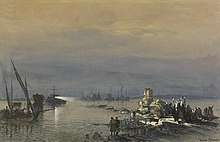

Also in 1915, Abdel Karim al-Khalil – the leader of the al-Khalil clan, who were the Tyrian allies of the al-Sulh dynasty from Sidon – was executed by the Ottoman regime "at the instigation" of Kamil al-As'ad from the rival Ali al-Saghir dynasty,[85] some believed.[83]
Still in 1915, fighting reached Tyre: in November of that year, four locals spying for the French intelligence were reportedly captured in Tyre and two of them executed in Beirut. The commander of the French Navy protected cruiser D'Estrés, who had demanded their release, in retaliation ordered the shelling of Tyre's harbour, where four boats were sunk. In February 1917, British intelligence agents undertook another operation to the area of Tyre to gather information about the Ottoman presence there.[108]
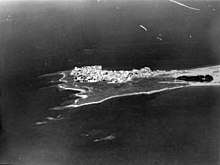
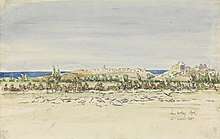
In September 1918, following the British victory at the Battle of Megiddo over the Ottoman Yildirim Army Group, the latter's remnants were forced to withdraw towards Damascus. The commander of the Egyptian Expeditionary Force General Edmund Allenby ordered his infantry and corps cavalry to capture the ports of Beirut and Tripoli to supply his forces in their Pursuit to Haritan of the retreating Ottoman troops.
Tyre was a strategic supply post on this route. Within three days, the second column of the British Indian Army's 7th (Meerut) Division paved the way across the Ladder of Tyre by expanding the narrow track over the steep cliff. Meanwhile, the XXI Corps Cavalry Regiment comprising one squadron Duke of Lancashire Yeomanry and two squadrons of 1/1st Hertfordshire Yeomanry advanced quickly and arrived in Tyre on 4 October.[109] On their way they encountered "few if any Turkish troops." Three days supplies were delivered by the Royal Navy to the port of Tyre for the infantry columns on their way north first to Sidon and then to Beirut.[110]
Pan-Arab Kingdom of Syria vs. French-British OETA (1918–1920)
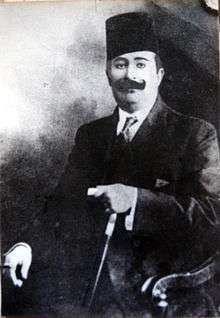
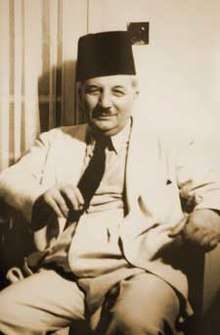
After the Arab Revolt against the Ottoman rule started in 1916 and the Sharifian Army conquered the Levant in 1918 with support from the British Empire, the Jamal Amil feudal leader Kamil al-As'ad of the Ali al-Saghir dynasty, who had been an Ottomanist before, declared the area – including Tyre – part of the Arab Kingdom of Syria on 5 October 1918.[85] However, the pro-Damascus regime in Beirut appointed Riad al-Sulh as governor of Sidon who in turn appointed Abdullah Yahya al-Khalil in Tyre as the representative of Faisal I.[105][83]
While the feudal lords of the As'ad / Ali al-Saghir and Sulh dynasties competed for power, their support for the Arab Kingdom put them immediately into conflict with the interests of the French colonial empire: on 23 October 1918, the joint British and French military regime of the Occupied Enemy Territory Administration (OETA) was declared, with Jabal Amel falling under French control.[85]
Subsequently, the French Army used the historical garrison building of Khan Sour as a base,[60] which had apparently been taken over as property by the Melkite Greek Catholic Archeparchy of Tyre[86] from the Franciscan Fathers.[60] In reaction, a guerrilla group started military attacks on French troops and pro-French elements in Tyre and the neighbouring areas, led by Sadiq al-Hamza from the Ali al-Saghir clan.[85]
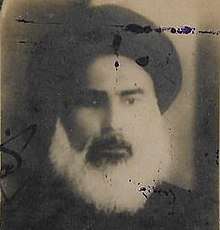
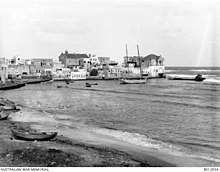
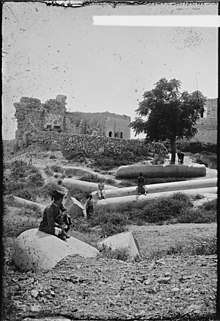
In contrast, the most prominent organiser of nonviolent resistance against the French ambitions in Jabil Amil became the Shi'a Twelver Islamic scholar Sayyid Abdel Hussein Sharafeddine (born 1872), the Imam of Tyre. He had played a decicive role in the 1908 power struggle between the al-As'ad clan of the Ali al-Saghir dynasty on the one hand side and the al-Sulh dynasty with their Tyrian allies of the al-Khalil family (see above) in favour of the former. His alliance with al-As'ad strengthened after WWI, as
"He achieved his prominent position in the community through his reputation as a widely respected 'alim [religious scholar] whose books were taught in prominent Shi'ite schools such as Najaf in Iraq and Qum in Iran."[85]
.svg.png)
.svg.png)
Thus he became the leading supporter of a Greater Syria,[71] while al-As'ad "waivered, waiting to see how events would turn out."[111] When the King-Crane Commission of the US government visited the region in 1919, Sharafeddin demanded US-support for a united Syria with Faisal as king:
"This angered the French who apparently encouraged an unsuccessful attempt to assassinate Sharaf al-Din."[85]
In early 1920, Sharafeddin led a Shia delegation to Damascus to make the case for unity with Syria.[106] At the same time tensions between Shia and Maronite groups in Jabal Amel increased, while Sharafeddin and al-As'ad promoted a pacifist approach and de-escalation,[85] though many French reports blamed the attacks by armed Shiites on Sharafeddin's financing and encouragement.[104]
When in April 1920 violent clashes took place in the Jabal Amel area between armed Shia and Maronite groups,[85] many Christians living in the hinterland of Jabal Amel had fled to Tyre.[111] A French colonial army assisted by Maronite volunteers then crushed the Shia rebellion.[85] Tyre, which was under siege by the insurgents,[112] and its population suffered from Bombardments by French warplanes and artillery.[113]
French Mandate colonial rule (1920–1943)
.svg.png)
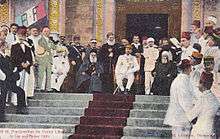
On the first of September 1920, the French colonial rulers proclaimed the new State of Greater Lebanon under the guardianship of the League of Nations represented by France. The French High Commissioner in Syria and Lebanon became General Henri Gouraud. Tyre and the Jabal Amel were attached as the Southern part of the Mandate.[113]
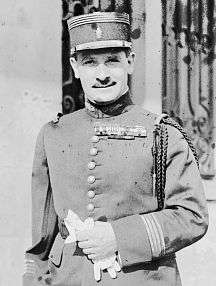
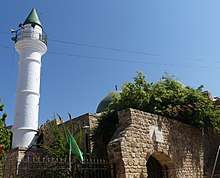
Still in 1920, the first municipality of Tyre was founded, which was headed by Ismail Yehia Khalil[114] from the Shia feudal dynasty of al-Khalil. The al-Khalil family had traditionally been allies of the al-Sulh clan, whereas Imam Sharafeddin supported the rival al-Asa'ad clan of the Ali al-Saghir dynasty since 1908 (see above). As the most prominent opponent of the French imperialist project Sharafeddin was forced to flee the city:
"His home in Tyre was looted by French soldiers, his books and manuscripts were confiscated, another home in a neighboring village was burned. He fled to Damascus, but had to quit that city for Egypt and then for a brief stay several months in Palestine before he was allowed to return to his base in Tyre."[106]
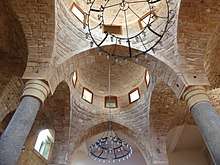
Meanwhile, the common people in Tyre and all of Southern Lebanon suffered from high taxes[104] and fines imposed on their economy to punish them for the failed rebellion.[85] In addition, the French colonial regime forcibly diverted agricultural products from Southern Lebanon to Syria and thus massively reduced trade activity in the port of Tyre.[115] Driven out by mass-poverty, emigration from Tyre via Marseille to Western Africa reached another peak. This trend was only curbed when the French colonial rulers in Africa imposed stricter controls on immigration at the end of the 1920s.[107]

In 1922, Kamil al-As'ad returned from exile and started an uprising against the French occupation, but was quickly suppressed and died in 1924.[85] In contrast, Imam Sharafeddin reached "rapprochement" with the colonial regime and entertained friendly relations with the military governor of South Lebanon, Zinovi Pechkoff,[104] whom he would regularly invite as guest of honour to religious events in Tyre.[116]
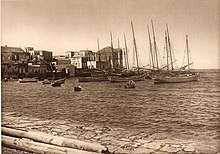
Sharafeddin thus resurged as the most defining character for the peaceful development of Tyre in the first half of the 20th century. While he succeeded his rival Khalil as head of the municipal council until 1926,[114] he first and foremost changed the city and its hinterland by becoming a social reformer[107] and "activist".[106]
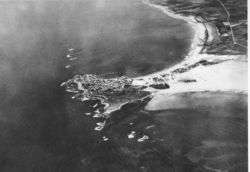
In 1926, the colonial regime officially recognised the Shia Ja'fari jurisprudence and subsequently – like in other cities – a Ja'fari tribunal opened in Tyre. It was headed by Sheikh Mughniya throughout the Mandate period.[116] Most visibly though, the first Shi'a mosque in Tyre was constructed in 1928, using local traditional architecture and centered around two Roman granite columns. It was named Abdel Hussein Mosque after Sharafeddine.[60]
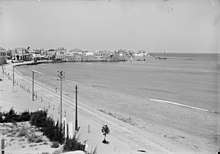
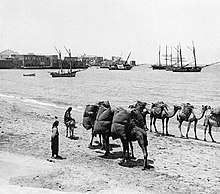
Yet despite Sharafeddine's efforts, the colonial appointments policy led to the fact that "almost all" of the particularly sensitive positions in the Tyre municipality and government were held by the Christian Salim family, which was headed by Yusuf Salim, a former deputy and the vice-director of "La Compagnie des Eaux de Beyrouth".[117]
According to the 1921 census, 83% of Tyre's population were Shiites, 4% Sunni, and some 13% Christians.[71] The Mandatory regime did little though to correct this gross under-representation of the Shia majority, but instead gave Shiite feudal families like al-As'ad and Khalil "a free hand in enlarging their personal fortunes and reinforcing their clannish powers."[117]
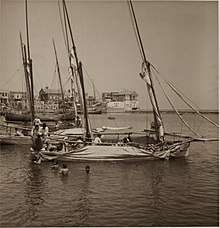
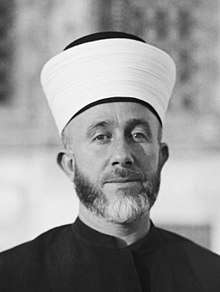
In 1936, the colonial authorities set up a camp for Armenian refugees in Rashidieh on the coast, five kilometres south of Tyre city.[118] One year later, another one was constructed in the El Bass area of Tyre.[119] Survivors of the Armenian Genocide had started arriving in Tyre already in the early 1920s. A branch of the Armenian General Benevolent Union was founded there in 1928.[120]
1938 saw a historical turning point, when Imam Sharafeddine founded a school for girls and boys. He pledged his private house to build the school, against the opposition of the feudal al-Khalil family. It soon expanded, also thanks to donations from the As'ad clan.[85] Whereas Christians had been benefitting from missionary schools, education for the Shia community was poor before the establishment of the Jafariya School:
"The school became the corner stone that changed the life of the Shi'ites in Jabal 'Amil in general and Tyre in particular."
The teaching staff consisted, however, not just of Shi'ites, but also of Christians, including headmaster Michael Shaban. The school soon also "became a nucleus for political activity", with Sharafeddin supporting especially the Palestinian demand for independence.[85] Shortly after the beginning of the 1936–1939 Arab revolt in Palestine, he had received the Grand Mufti of Jerusalem Amin al-Husseini, who evaded a British arrest warrant, in Tyre against the efforts of the French regime and thanks to crowds of popular support.[104]
The borders were open during those times, and many Palestianian Jews used to spend holidays in Tyre, while vice versa many Southern Lebanese would travel freely to Haifa and Tel Aviv.[121]
World War II
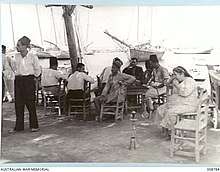
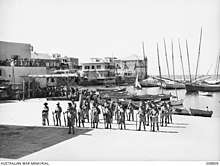
After the start of the Second World War, French troops once again used the historical garrison building of Khan Sour as a base.[60][87]
In 1940, French soldiers loyal to Marshal Philippe Pétain dug out an anti-tank trench at Tyre on the road leading South and discovered a marble sarcophagus from the first or second century CE, which is exhibited at the National Museum in Beirut.[122]
In mid-1941, the joint British-Free French Syria–Lebanon campaign began to topple the Vichy regime in Syria and Lebanon. It relied heavily on Indian troops[123] and also included the Australian 21st Brigade.[124] These forces liberated Tyre from the Nazi-collaborators on 8 June.[125]
It is not known how Tyre experienced the end of colonial rule and the transfer of power in the two years leading up to Lebanese independence on 22 November 1943.
1943 Lebanese independence
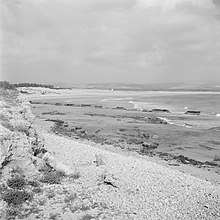
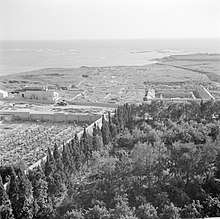
When France dispatched troops to Beirut during the 1945 Levant Crisis, it was Imam Sharafeddin who sent a petition to the Legation of the United States in the capital:
"We inhabitants of Jabal Amil protest strongly against landing of foreign troops in our country, which is free. This is a slighting of our liberty and a disdain of our honor. We are prepared to defend our independence. We would not hesitate to shed the last drop of our blood to that effect."[106]
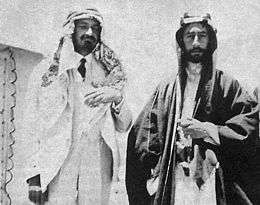
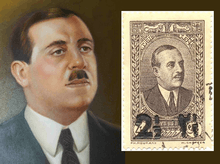
In 1946, Jafariya School was upgraded to be a Secondary School, the first in Southern Lebanon. Imam Sharafeddine appointed as its founding director George Kenaan, a Lebanese Christian. The expansion was possible especially thanks to funding from merchants who had emigrated from Tyre to Western Africa and made their fortunes there.[107]
In contrast, a school project by Sharafeddin's political rival Kazem al-Khalil failed despite support from prime minister Riad al-Sulh, to whose family the al-Khalil feudal dynasty was traditionally allied.[85]
Meanwhile, the Maronite political leader Émile Eddé – a former Prime Minister and President – reportedly suggested to the Zionist leader Chaim Weizmann[126] that a Christian Lebanon
"should relinquish some portions of the no longer wanted territory, but to the Jewish state-in-the-making. It could have Tyre and Sidon and the 100,000 Muslims living there, but when he put the matter to Weizmann, even he balked at what he called 'a gift which bites'."[121]
1948 Palestinian exodus
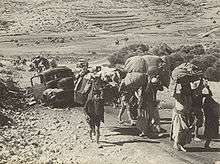
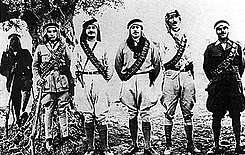
When the state of Israel was declared in May 1948, Tyre was immediately affected: with the Palestinian exodus – also known as the Nakba – thousands of Palestinian refugees fled to the city, often by boat. Many of them were given shelter by Imam Sharafeddin in the Jafariya School.[85]
On 17 July 1948, two Israeli Frigates shelled Tyre[127] to attack a unit of Fawzi al-Qawuqji's Arab Liberation Army (ALA).[128] When the Israel Defense Forces (IDF) conducted Operation Hiram in October 1948 to capture Upper Galilee from the ALA, thousands more Palestinians fled to Southern Lebanon. Many of them found refuge in Tyre. Subsequently, its position next to the closed border further marginalised the city, "which was already sidelined by Beirut and Sidon."[16]
Still in 1948, the Burj El Shimali camp was established next to the Tyre peninsula, mainly for displaced from Hawla, Lubieh, Saffuri, and Tiberias.[129] The same year, an irregular camp was established at the Jal Al Bahar coastal strip in the Northern part of Tyre,[130] mainly by Palestinian refugees from the village of Tarshiha.[131] In Maachouk – 1 km to the West of Burj El Shimali – Palestinian refugees settled on agricultural lands owned by the Lebanese State.[132] In the course of the 1950s, the Armenian refugees from El Bass were resettled to the Anjar area, while Palestinians from the Acre area in Galilee moved into the camp.[119]
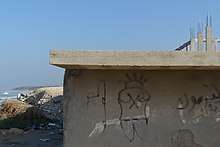
Palestinian refugees played a key role in developing the citrus plantations in Tyre area, but were also competing for cheap labour opportunities in this field with the Lebanese precariat.[115] On the other side, many of the teachers at the Jafariya Primary and Secondary school were well-educated refugees from Palestine, amongst them the famous cartoonist Naji al-Ali, who worked as a drawing instructor in the early 1960s and went on to create Handala, the iconic symbol of Palestinian identity and defiance.[133]
In 1950, the new building of the Jafariya School was inaugurated and named Binayat al-Muhajir – "Building of the Emigrants" – honouring the contributions from wealthy Tyrians in Africa.[85] At the same time, the number of Lebanese from Tyre joining that diaspora increased once again, corresponding to yet another rise in poverty.[107]
In 1956, the Jafariya School was the platform for a guerrilla group of 25 Lebanese and Palestinian students to launch military strikes in Israel. However, at the end of that year their weapons were confiscated by the military intelligence and the Palestinian headmaster Ibrahim al-Ramlawi was arrested.[85]
It is unclear whether the 1956 Chim earthquake, which killed some 136 people in the Chouf District, caused any injuries or damages in Tyre as well.
On 31 December 1957, Imam Sharafeddine, the founder of modern Tyre, died at the age of 85 and at a point of time when tensions escalated once again:[85]
1958 Lebanese Civil War
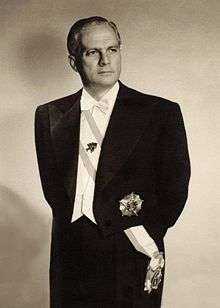
When President Camille Chamoun introduced a new electoral system in 1957, Ahmed al-Asaad from the feudal Ali al-Saghir dynasty, who at the beginning of the decade had even been the Speaker of the Lebanese parliament, for the first time lost the vote for deputy (MP). He had presented his candidacy in Tyre, the stronghold of his Shia rival Kazem al-Khalil, rather than in his traditional home base of Bint-Jbeil.[134]
As a consequence, al-Asaad became a "major instigator of events against Chamoun" and his allies, primarily al-Khalil,[85] who likewise was a long-time member of parliament and the scion of a family of large landowners ("zu'ama") ruling through patronage systems:[135][136][137]
"The Khalils, with their age-old ways, [..] were known for being particularly rough and hard."[106]
During the 1958 crisis, Kazem al-Khalil was the only Shi'ite minister in the cabinet of Sami as-Sulh, to whose family the al-Khalil feudal dynasty was traditionally allied. Thus,
"Kazim's followers had a free hand in Tyre; they could carry Guns on the streets".[85]
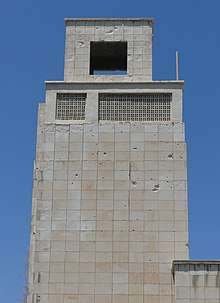
Then, after the formation of the United Arab Republic (UAR) under Gamal Abdel Nasser in February 1958, tensions escalated in Tyre between the forces of Chamoun and supporters of Pan-Arabism. Demonstrations took place – as in Beirut and other cities – that promoted pro-union slogans and protested against US foreign policy.[138] The Jafariya school became the base of the opposition.[85]
.svg.png)
Still in February, five of its students were arrested and "sent to jail for trampling on the Lebanese flag and replacing it with that of the UAR."[139] Hussein Sharafeddin, a son of Imam Abdul Hussein Sharafeddin and as the director of Jafariya a leader in the protests, was imprisoned, too.[134]
"The issue caused violent parliamentary wrangling between [..] Kazem al-Khalil, and the Greek-Catholic twin brothers Nicolas and Joseph Slam, who were accused by him of fanning riots."[134]
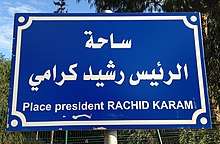
On 28 March, soldiers and followers of Kazem al-Khalil opened fire on demonstrators and – according to some reports – killed three.[85] On the second of April, four[140] or five protestors were killed and about a dozen injured.[138] Al-Khalil alleged "that some of the demonstrators had thrown sticks of dynamite before the gendarmes fired", but this was not corroborated.[140]
Subsequently, opposition leaders like Rashid Karami expressed support for the people of Tyre, and the neighbouring city of Sidon/Saida joined the strike.[138] A US-Diplomat, who travelled the region shortly afterwards, reported though that the clashes were more related to the personal feud between al-Asaad and al-Khalil than to national politics.[134]
In May, the insurgents in Tyre gained the upper hand.[141] Ahmad al-As'ad[85] and his son Kamil al-Asaad supported them, also with weapons.[142] According to a general delegate of the International Committee of the Red Cross (ICRC) who visited in late July, "heavy fighting went on for 16 days".[143] Kazem al-Khalil was expelled from the city and the Sharafeddin family "took over control".[85] While the rebels held the old town, the government forces controlled all access to the peninsula. The ICRC got permission from them for regular relief distributions.[143]
The crisis dissolved in September, when Chamoun stepped down. Al-Khalil returned still in 1958, but was attacked several times by gunmen.[85] Despite the victory of the al-As'ad dynasty who had played a dominant role in Tyre and Jabal Amel for almost three centuries, its power began to crumble at the same time with the arrival of a newcomer:
Musa Sadr era (1959–1978)
.jpg)
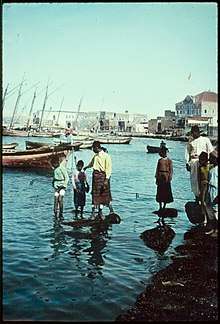
After Imam Sharafeddin's death in 1957, his sons and other representatives of the Shia community of Southern Lebanon asked his relative Sayyid Musa Sadr to be his successor as Imam.[144] Sharafeddine had invited the Iran-born Sadr for his first visits to Tyre in previous years[145]
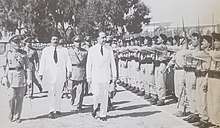
In 1959, Sadr moved to Tyre and at first encountered not only suspicion, but also opposition.[106] Yet, within just a few years he managed to create a broad following.[71] As "one of his first significant acts" he established a vocational training center in neighbouring Burj El Shimali that became "an important symbol of his leadership"[144] as well as other charity organisations.[85] His base became the Abdel Hussein Mosque at the entry of the old town.[60] On the national level, Sadr closely cooperated with the regime of General Fuad Chehab, who succeeded Chamoun in late 1958 as President of the Republic.[106]
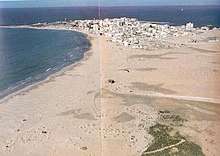
In 1960, the feudal lord Kazem al-Khalil lost his seat as deputy in parliament in the national election despite his alliance with wealthy expatriates in West Africa,[146] allegedly also due to intrigues of the Lebanese Deuxième Bureau intelligence agency.[147] In contrast, one of Sharafeddin's sons - Jafar Sharafeddin - was elected in 1960 as a Ba'athist. In parliament, to which he was re-elected in 1964,[85] he made the following plea, which arguably summarises the precarious socio-economic situation in the mid-20th century most precisely:
"The district of Tyre has sixty villages, to which God Almighty has given all kinds of beauty. But the rulers of Tyre have deprived Tyre and the surroundings of their rights. Of these sixty villages only a dozen or so have anything that could be called a school or a paved road. Forty villages are without a school. These sixty villages go thirsty in this age of science and the machine, while a river [the Litani] passes them by on the way to the sea. All sixty villages lack electricity. Electricity is the fortune of more privileged districts. .. These sixty villages are deserted, inhabited by old men and women; the young ones have departed to toil in the heat of Africa. Thousands more have come to Beirut, to toil among others of their kind. Tyre itself, the heart of the district, has suffered what no city can suffer. It has become a deformed, ruined place. Everything in it falls short of what a civilised place should be. The government should restore to Tyre its splendor."[106]
.jpg)
By the 1960s, Tyre had a population of some 15,000 inhabitants.[91] In the course of the decade it increasingly became subject to a rural-to-urban movement that has been ongoing ever since.[6] In addition, the arrival of Palestinian refugees continued: In 1963, the United Nations Relief and Works Agency for Palestine Refugees (UNRWA) set up a "new camp" in Rashidieh to accommodate refugees from Deir al-Qassi, Alma, Suhmata, Nahaf, Fara and other villages in Palestine.[118]
Towads the end of the decade, public discontent in Tyre grew as it did in other parts of the country. A protest movement started in March 1967 with a long strike by secondary students who amongst other things demanded lower fees: "In Tyre, the gendarmes fired on a demonstration, killing a student, Edward Ghanima."[148]
In May 1967, Sadr established the Supreme Islamic Shia Council (SISC) - a strategic move that would go on to change the political landscape not only of Jabal Amel, but also of the whole of Lebanon:[85]
1967 Six-Day War
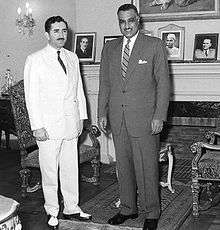
After the Six-Day War of June 1967 another wave of displaced Palestinians sought refuge in South Lebanon. In the following year, there were almost 25,000 registered Palestinian refugees in the camps of Tyre: 3,911 in Al Bass, 7,159 in Burj El Shimali, and 13,165 in Rashidieh.[149] More found shelter in the neighbourhood of Maachouk and the gathering of Jal Al Bahar.
In the 1968 elections for the national parliament, about 40,000 Tyrians were entitled to elect three Shiite representatives as deputies: the greatest number of votes went to the two candidates allied to veteran prime minister Rachid Karami: both lawyer Muhammad Safi Al-Din and businessman Ali Arab, who had made his fortune in South America, were former ministers and long-time deputies. The third seat went to Baathist Jafar Sharafeddin, who was supported by Karami in the 1958 Civil War.[150]
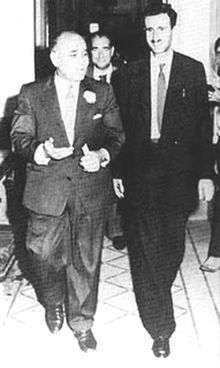
Kazem al-Khalil, Tyre's main feudal lord and long-time MP, who already lost the elections in 1960 and 1964,[137] came in at a close fourth place. Hence, the former minister complained about "armed demonstrations, bribery, and arrests".[150] While the extent of apparent irregularities could not be determined, there is evidence that Khalil himself had sought financial assistance from the US Embassy in Beirut.[151]
The solidarity of the Lebanese Tyrians with the Palestinians was especially demonstrated in January 1969 through a general strike to demand the repulsion of Israeli attacks on Palestinian targets in Beirut.[152] However, these expressions of sympathy were not to be confused with Antisemitism, since Lebanese Jews still felt safe to visit Tyre.[77] At the same time though, the arrival of civilian refugees went along with an increasingly strong presence of Palestinian Militants. Thus, clashes between Palestinians and Israel increased dramatically:
On 12 May 1970, the IDF launched a number of attacks in South Lebanon, including Tyre. The Palestinian insurgency in South Lebanon escalated further after the conflict of Black September 1970 between the Jordanian Armed Forces (JAF) and the Palestine Liberation Organization (PLO).[85] The PLO allegedly also trained Nicaraguan Sandinista rebels in Tyre.[153]
In the 1972 national elections, former Baathist Ali al-Khalil won one of the deputy seats for Tyre District.[154] His namesake Kazem al-Khalil regained his seat with support from a rich expatriate in Nigeria and became one of the fiercest opponents of the Palestinian fighters in parliament.[146] His traditional opponent Jafar Sharafeddin had been Minister of Water resources from 1970 onwards in a technocratic government by Saeb Salam. Now, he was instead appointed as Presidential Adviser for hydroelectric resources.[155] Meanwhile, as a traditional ally of Kamil al-As'ad from the Ali al-Saghir dynasty, Sharafeddin became more alienated from Sadr, who opposed the zu'ama feudal landlords altogether.[85]
In early 1973, growing public discontent manifested itself again in "wildcat strikes and violent demonstrations" in Tyre as in other cities.[148]
1973 Yom Kippur War
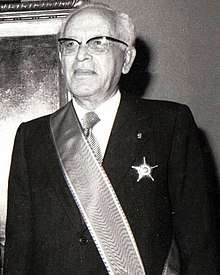
The 1973 October Yom Kippur War signalled even more Palestinian military operations from Southern Lebanese territory, including Tyre, which in turn increasingly sparked Israeli retaliation.[85]
In this environment, Imam Sadr was balancing the relations between the Maronite-dominated state, the Palestinian resistance with its leftist Lebanese supporters, and his own Shia community, which increasingly harboured popular discontent with the PLO domination in Southern Lebanon and being caught in the crossfire with Israel. There, Sadr's power struggle with the traditional feudal rulers escalated: thanks to the backing of the SISC Sadr managed to gradually break up the inherited power of Kamil al-As'ad – a close ally of President Suleiman Frangieh[85] – from the Ali al-Saghir dynasty after almost three centuries,[156] although al-As'ad's list still dominated the South in the parliamentary elections of 1972 and the by-elections of 1974.[85]
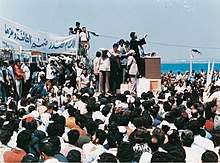
Likewise, the large landlord Kazem al-Khalil in Tyre, who had been a fierce opponent of both As'ad and Sadr,[157][137] re-gained his parliamentary seat in 1972,[85] but was soon marginalised by two other organisations that Sadr set up:
In 1974, Sadr founded Harakat al-Mahroumin ("Movement of the Deprived"). While it reached out beyond the Shia communities of Southern Lebanon to those fragmeted ones in the Bekaa Valley and Beirut for creating a united Shia identity in the Lebanese context,[85] Sadr also sought close cooperation with the Christian minorities,[158] especially the Greek-Catholic Melkites under the leadership of Tyre's archbishop Georges Haddad.[159]
.jpg)
It is estimated that some 80 thousand of Sadr's followers rallied in Tyre on 5 May 1974,[157] with weapons on open display.[85] Shortly afterwards, the Israeli military attacked: on May 19th, the Israeli Navy reportedly shelled Rashidieh, killing 5 people and injuring 11. On 20 June, the Israeli Air Force (IAF) bombed the two main refugee camps in Tyre. According to the Lebanese army, 5 people were killed and 21 injured in Rashidieh, while 8 were killed and 30 injured in Burj El Shemali.[160]
In this context, despite his pledges to nonviolent means, Sadr also founded the de facto military wing of his movement in 1975, just before the outbreak of the civil war: the Afwaj al-Muqawama al-Lubnaniyya (Amal).[156]
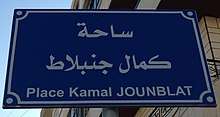
The Iranian director of Sadr's technical school in Tyre, Mostafa Chamran, became a major instructor of guerilla warfare. The US-trained physicist went on to become the first defense minister of post-revolutionary Iran.[161] Other key figures of the Iranian opposition, like Sayed Ruhollah Khomeini's close aide Sadeq Tabatabaei, were frequent visitors of Tyre.[162] In contrast, Khalil al-Khalil - one of the sons of Kazem al-Khalil - served as Lebanon's Ambassador to the Imperial State of Iran from 1971 to 1978.[155]
On the national stage of politics, one of Sadr's main allies was the Lebanese Druze leader Kamal Jumblatt. However, frictions between them led to a break-up of their coalition soon after the beginning of the civil war in 1975:[85] under Jumblatt's leadership the National Lebanese Movement (NLM) allied itself to the PLO.
Lebanese Civil War (1975–1990)
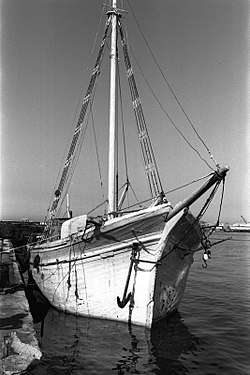

In January 1975, a unit of the Popular Front for the Liberation of Palestine (PFLP) attacked the Tyre barracks of the Lebanese Army.[71] The assault was denounced though by the PLO as "a premeditated and reckless act".[152] Also, one of the residences of feudal lord Kazem al-Khalil "was dynamited" and another one of his homes "was seized by Palestinian guerrillas".[163]
In February 1975, Tyre saw pro-PLO and anti-government demonstrations after Arab Nationalist MP Maruf Sad had been killed in Sidon, allegedly by the army.[154] Then, in early March 1975, a PLO commando of eight militants sailed from the coast of Tyre to Tel Aviv to mount the Savoy Hotel attack, during which eight civilian Hostages and three Israeli soldiers were killed as well as seven of the attackers.[164] Five months later - on 5 August 1975 - Israel attacked Tyre "from land, sea and air". More assaults followed on 16 and 29 August, as well as on 3 September.[165]
In 1976, local commanders of the PLO took over the municipal government of Tyre with support from their allies of the Lebanese Arab Army.[152] They occupied the army barracks, set up roadblocks and started collecting customs at the port.[166] Parts of Kazem al-Khalil's estate were confiscated as well.[83] However, the new rulers quickly lost support from the Lebanese-Tyrian population because of their "arbitrary and often brutal behavior".[166] Even Tyre's veteran politician Jafar Sharafeddin,[155] whose family has promoted freedom for the Palestinians over generations, was quoted as criticising the PLO for "its violations and sabotage of the Palestinian cause" during that time.[104]
.jpg)
When Syria invaded Lebanon in mid-1976, it committed to a proposal by the Arab League not to cross the Litani River southwards. So while the Lebanese Civil War had started in South Lebanon, it was spared from much of the internal fighting. However, many young men from the area moved northwards to take part in combat.[167] At the same time, Israel started engaging in a naval blockade of Tyre harbour and other Southern Lebanese ports to cut off supplies to the PLO, choking off most other maritime trade there as well.[168]
In July 1977, three Lebanese fishermen in Tyre were killed by an Israeli attack. Palestinian militants retaliated with rocket fire on the Israeli town of Nahariya, killing three civilians. Israel in turn retaliated by killing "over a hundred" mainly Lebanese Shiite civilians in the Southern Lebanese countryside.[121]
Thus, it was again especially the common people of Tyre and its hinterlands, who greatly suffered from the political conflicts.[16] Due to growing mass-poverty a new wave of emigration from Tyre area to West Africa, especially to Ivory Coast, though not so much to Senegal as before.[107]
1978 South Lebanon conflict with Israel
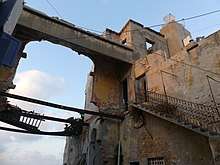
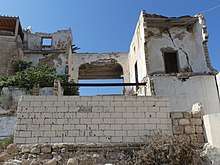
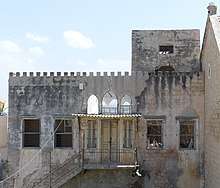
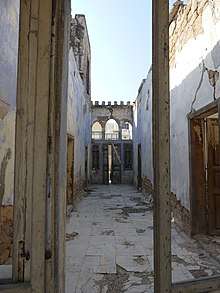
On 11 March 1978, Dalal Mughrabi – a young woman from the Palestinian refugee camp of Sabra in Beirut – and a dozen Palestinian fedayeen fighter sailed from Tyre to a beach north of Tel Aviv. Their attacks on civilian targets became known as the Coastal Road massacre that killed 38 Israeli civilians, including 13 children, and wounded 71.[121] According to the United Nations, the
PLO "claimed responsibility for that raid. In response, Israeli forces invaded Lebanon on the night of 14/15 March, and in a few days occupied the entire southern part of the country except for the city of Tyre and its surrounding area."[169]
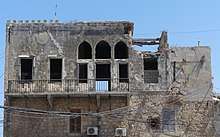
Nevertheless, Tyre was badly affected in the fighting during the Operation Litani,[170] with civilians bearing the brunt of the war, both in human lives and economically:[71] The IDF targeted especially the harbour on claims that the PLO received arms from there and the Palestinian refugee camps.[171] Bombardments by the IAF destroyed historical buildings, including the estate of Beit Shaddad, and heavily damaged many others, mainly in the Christian quarter.
"On 15 March 1978, the Lebanese Government submitted a strong protest to the Security Council against the Israeli invasion, stating that it had no connection with the Palestinian commando operation. On 19 March, the Council adopted resolutions 425 (1978) and 426 (1978), in which it called upon Israel immediately to cease its military action and withdraw its forces from all Lebanese territory. It also decided on the immediate establishment of the United Nations Interim Force in Lebanon (UNIFIL). The first UNIFIL troops arrived in the area on 23 March 1978."[169]
However, the Palestinian forces were unwilling to give up their positions in and around Tyre. UNIFIL was unable to expel those militants and sustained heavy casualties. It therefore accepted an enclave of Palestinian fighters in its area of operation which was dubbed the "Tyre Pocket". In effect, the PLO kept ruling Tyre with its Lebanese allies of the NLM, which was in disarray though after the 1977 assassination of its leader Kamal Jumblatt.[71]
Post-Sadr Era (since 1978)
Amal-PLO-Israel conflicts

Only a few months after the conflict, Amal-Leader Musa Sadr mysteriously disappeared following a visit to Libyan leader Muammar Gaddafi on 31 August 1978.[106] His legacy has continued into the present: he has been widely credited with "bringing the Shi'ite community onto an equal footing with the other major Lebanese communities."[85] And while the loss of Sadr was great, it also became and has remained a major rallying point for the Shia community across Lebanon, particularly in Southern Lebanon.[156]
Frequent IDF bombardments of Tyre from ground, sea and air raids continued after 1978.[172] In January 1979, Israel started naval attacks on the city.[173] The PLO reportedly converted itself into a regular army by purchasing large weapon systems, including Soviet WWII-era T-34 tanks, which it deployed in the "Tyre Pocket" with an estimated 1,500 fighters.[71]
On the 27th April 1981, the Irish UNIFIL-soldier Kevin Joyce got kidnapped by a Palestinian faction from his observation post near the village of Dyar Ntar and, "according to UN intelligence reports, was taken to a Palestinian refugee camp in Tyre. He was shot dead a few weeks later following a gun battle between Palestinians and UN soldiers in south Lebanon."[174]
The PLO kept shelling into Galilee until a cease-fire in July 1981.[71] On the 23rd of that month, the IDF had bombed Tyre.[175]
As discontent within the Shiite population about the suffering from the conflict between Israel and the Palestinian factions grew, tensions between Amal and the Palestinian militants escalated into violent clashes in many villages of Southern Lebanon, including the Tyre area.[173] In the city itself, the heaviest such incident took place in April 1982, when the PLO (Fateh) bombarded Amal's Technical Institute in Burj El Shimali for ten hours.[176]
1982 Lebanon War with Israel and Occupation
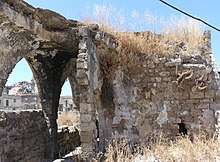
Following an assassination attempt on Israeli ambassador Shlomo Argov in London the IDF started an invasion of Lebanon on 6 June 1982, which heavily afflicted Tyre once again:
Shelling by Israeli artillery[170] and air raids killed some 80 people on the first day. Though the PLO had reportedly left its positions on the peninsula,[177] urban Tyre with the market area in particular was heavily bombarded as well. Historical buildings like the Serail[60] and Khan Sour were partly destroyed.[87] The latter had been taken over by the Al-Ashkar family from the Melkite Greek Catholic Archeparchy of Tyre after WWII and became known as Khan Al-Ashkar.[86]
However, the Palestinian camps were bearing the brunt of the assault, as many guerillas fought till the end.[121] Noam Chomsky recorded that
"The first target was the Palestinian camp of Rashidiyeh south of Tyre, much of which, by the second day of the invasion, 'had become a field of rubble.' There was ineffectual resistance, but as an officer of the UN peace-keeping force swept aside in the Israeli invasion later remarked: 'It was like shooting sparrows with cannon.'"[178]
On 7 June, the Greek-Catholic (Melkite) archbishop Georges Haddad succeeded in temporarily halting the attack of an IDF tank column in a bold appeal to the Israeli commander, mediated by a Swiss delegate of the ICRC, to evacuate the civilian population to the beaches.[177] The fighting stopped after two days, but the humanitarian consequences were severe,[179] also because "the IDF had few plans for management or detention of masses of civilians, let alone for feeding."[172]
.jpg)
The government of Lebanon claimed that the IDF attacks killed some 1,200 civilians and injured more than 2,000 Non-combatants,[180] whereras the IDF claimed that "only" 56 civilians were killed in the Tyre District.[71] Estimates of IDF casualties during combat in Rashidieh and Burj El Shimali ranged between 21[181] and "nearly 120".[182]
UNRWA recorded that in Rashidieh alone "more than 600 shelters were totally or partially destroyed and more than 5,000 Palestine refugees were displaced."[118] Those in the Burj El Shimali camp were heavily affected as well[129] There were 11,256 registered Palestinian refugees in Burj El Shimali at the time, and 15,356 in Rashidieh,[149] altogether more than the entire population of urban Tyre which was estimated to be around 23,000.[183] Much of the destruction was done "systematically" by the IDF after the fighting stopped,[184] leaving some 13,000 Palestinians homeless in the Tyre area.[185] Only El Bass camp with 5,415 registered Palestinians[149] was spared much of the violence.[119]
Still in June 1982, the Israeli forces temporarily arrested some 14,000 men in Tyre and paraded them in front of hooded collaborators who advised the occupators whom to detain.[184] At the same time, the IDF set up a large compound in Burj el-Shemali right next to the Amal technical training center founded by Musa Sadr:
"The centre doubled as office of the Amal leader in South Lebanon, Dawud Sulayman Dawud, nicknamed 'David David' because of his alleged readiness to negotiate with Israel. He was a native of Tarbikha, one of the five Shi'ite villages in northern Galilee, which were depoluated in October/November 1948, and his Lebanese opponents often called him a Palestinian. Dawud and other Amal leaders did not avoid discreet contacts with Israelis, but refused open clientship. The IDF soon lost patience and arrested thirteen Amal leaders as early as the summer of 1982."[71]
Moreover, the IDF set up a military post in Tyre and sponsored the return of Shia feudal lord Kazem al-Khalil to the city in July 1982 after an absence of seven years. When his attempts to reconcile with Amal failed, he formed a small militia of some 40 men with Israeli support,[186] recruiting mainly young Shiites from a poor background.[71] However, al-Khalil's collaboration not only "discredited"[71] and "delegitimised him in the eyes of the Shi'a, but also earned him the anger of the Syrians. This simple miscalculation was an act from which he was never able to fully recover politically".[83]
Amal, on the other hand, in September 1982 managed to mobilise an estimated 250,000 supporters in Tyre to commemorate the disappearance of Musa Sadr.[71] Shortly afterwards, though, a new force appeared that would go on to dominate the scene – Hezbollah:
On 11 November 1982, the fifteen-year-old Ahmed Qasir, who had reportedly lost several members of his family in the Israeli invasion of 1978,[121] carried out a suicide-attack with an explosive-laden car. His target was the Israeli military headquarters in Tyre, a high-rise building that also housed the paramilitary Border Guards. In addition, it was reportedly a hub for the military intelligence A'man and the internal security service Shin Bet. All seven floors collapsed.[187] Statements about casualties of operation "Jal Al Bahar" - named after the Palestinian gathering - differ: according to some sources, ninety Israeli soldiers and officers were killed as well as an unknown number of Lebanese and Palestinians who were detainees in the complex.[113] According to others, 67 IDF and Border Guards personnel along with nine Shin Bet agents were killed, as well as fifteen local detainees. In any event, it was
"one of the deadliest days in Israeli military history."[187]
Almost one year later, in October 1983, another such attack on the new Israeli headquarters in Tyre killed 29 Israeli soldiers and officers, wounding another thirty[113] as confirmed by the Israeli government.[188] 32 Lebanese and Palestinians died as well, most of them detainees.[71] Only in 1985 did Hezbollah claim responsibility for the two operations.[113] In February of that year, an Amal member from Tyre launched a suicide-attack on an IDF convoy in Burj El Shimali,[161] injuring ten soldiers. "Israeli reprisals in the area east of Tyre killed fifteen and wounded dozens."[71]
1985 Israeli Withdrawal and Amal-PLO-Hezbollah conflicts
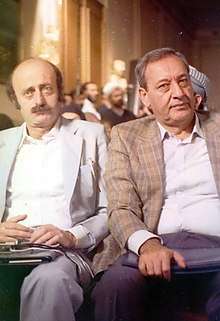
Under the growing pressure the Israeli forces withdrew from Tyre by the end of April 1985[71] and instead established a self-declared "Security Zone" in Southern Lebanon with its collaborating militia allies of the South Lebanon Army (SLA). Tyre was left outside the SLA control though[188] and taken over by Amal under the leadership of Nabih Berri,[176][71] who was a graduate of Jafariya High School.
"Amal formed the Committee for the Development of Sour, which funded infrastructural repairs and [..] subsequently transferred responsibility over to the municipality."[189]
At once, Amal arrested the pro-Israeli militia leader in Tyre, Ibrahim Farran, and another main-collaborator, Shawqi Abdallah,[71] but unlike in other areas there were no forced displacements of Christians in Tyre and Tyre area.[158]
"The priority of Amal remained to prevent the return of any armed Palestinian presence to the South, primarily because this might provoke renewed Israeli intervention in recently evacuated areas. The approximately 60,000 Palestinian refugees in the camps around Tyre (al-Bass, Rashidiya, Burj al-Shimali) were cut off from the outside world, although Amal never succeeded in fully controlling the camps themselves. In the Sunni 'canton' of Sidon, the armed PLO returned in force."[71]

Tensions between Amal and Palestinian militants soon escalated once again and eventually exploded into the War of the Camps, which is considered as "one of the most brutal episodes in a brutal civil war":[190] In September 1986, a group of Palestinians fired on an Amal patrol at Rashidieh. After one month of siege, Amal attacked the refugee camp in the South of Tyre.[176] It was reportedly assisted by the Progressive Socialist Party of Druze leader Walid Jumblatt, whose father Kamal had entered into and then broken an alliance with Amal-founder Musa Sadr, as well as by the pro-Syrian Palestinian militia As-Saiqa and the "Popular Front for the Liberation of Palestine – General Command".[191] Fighting spread and continued for one month. By that time some 7,000 refugees in the Tyre area were displaced once more:[176]
"Amal [..] overran the unarmed camps of El Buss and Burj el-Shemali, burning homes and taking more than a thousand men into custody."[192]
In February 1988 though, "Amal seemed to lose control" when US-Colonel William R. Higgins, who served in a senior position of the United Nations Truce Supervision Organization (UNTSO), was kidnapped just South of Tyre on the coastal highway to Naqoura by armed men suspected of being affiliated with Hezbollah. The incident took place following a meeting between Higgins and a local Amal leader and led to renewed clashes between Amal and Hezbollah, mainly in Beirut. Amongst the casualties was Amal's leader for South Lebanon leader, Dawood Dawood, causing "an outpour of popular grief in Tyre".[71]
The final phase of the Lebanese Civil War in 1990 coincided with the death of feudal lord and veteran Tyre politician Kazem al-Khalil, who succumbed to a heart-attack in his Paris exile.[83]
Post-Civil War
.jpg)
Following the end of the war in March 1991 based on the Taif Agreement, units of the Lebanese Army deployed along the coastal highway and around the Palestinian refugee camps of Tyre.[147]
The long occupation left Southern Lebanon in general and Tyre in particular "depressed long after the 1991 cease fire" of the civil war.[16]
In the 1992 elections, Kamil al-As'ad from the feudal dynasty of Ali al-Saghir headed a list that lost against Amal. Nasir al-Khalil, the son of Tyre's former longtime deputy Kazim al-Khalil who died in 1990, was not elected either[193] and failed again in 1996.[83] However, a decade later another scion of this "neo-feudal" clan - Ali Hassan al-Khalil - joined Amal and thus won a parliamentary seat against Ahmed al-As'ad from the arch-rival Ali al-Saghir dynasty, though not in Tyre but in Marjayoun Hasbaiya.[194]
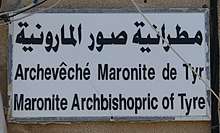
In April 1996, Israel launched the sixteen-day campaign Operation Grapes of Wrath against Lebanon in an attempt to stop rocket attacks by Hezbollah. As part of the conflict, the Israeli Navy blockaded the harbour of Tyre. A UNIFIL convoy carrying food supplies to besieged villagers near Tyre was reportedly shelled by the IDF. Tyrian hospitals were overcrowded with civilian victims of bombardments throughout the conflict.[195]
After Israeli shelling hit the UNIFIL compound in the nearby village of Qana on 18 April, killing 106 civilians and injuring another 116 (as well as 4 UN workers from Fiji), the central mourning ceremony was held in the Roman Hippodrome of Tyre following the ceasefire at the end of April. The number of attendants honouring the victims of the Qana massacre was estimated at more than 20.000, including Prime Minister Rafiq Hariri and Speaker of Parliament Nabih Berri as well as leading clerics of various Muslim and Christian denominations.[196]
A few weeks later, the Maronite Archeparchy of Tyre gave up a portion of its traditional territory, as the Maronite Catholic Archeparchy of Haifa and the Holy Land was created. Until 1996, the archbishop had visited his flock across the Blue Line like in past centuries, when Tyre was part of a Greater Palestine with open borders. This cross-border mandate now became untenable.
In the 1998 Municipal Elections, Amal won "a startling victory of twenty one seats in Tyre" ahead of Hezbollah, led by Sayed Hassan Nasrallah. Six years later, Amal held Tyre as its traditional stronghold, but lost support in the District of Tyre to Hezbollah.[113]
2006 Lebanon War
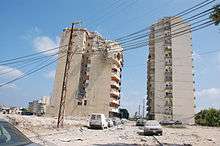
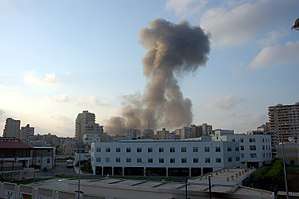
During Israel's invasion in the July 2006 Lebanon War, several rocket-launching sites used by Hezbollah to attack Israel were located in rural areas around the city.[197] IDF commandos raided a building on the outskirts of Tyre killing at least two Hezbollah fighters,[198] and Shayetet 13 (Israeli naval commandos) also raided Hezbollah targets within the city.[199]
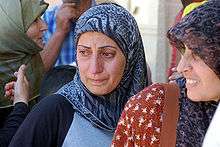
While some Lebanese army soldiers were killed in such attacks as well,[200] most of the victims were civilians. At least one village near the city was bombed by Israel as well as several sites within the city, causing civilian deaths and adding to the food shortage problem inside Tyre:[201]
– On 16 July around noon a strike by the IAF on a residential apartment building behind the Jabal Amel Hospital – known as the Sidon Institute – at the outskirts of Tyre killed eight members of a family.
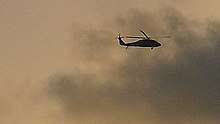
– At about the same time, five civilians were killed by another aerial assault on Burj El Shimali, including two children.

– Later in the afternoon of that same day, another airstrike on a multistorey apartment building in Tyre, which also housed the Civil Defense Forces, killed 14 civilians, amongst them a one-year-old girl and a Sri Lankan maid.[198]
– On 21 July, army soldiers reportedly buried 72 victims in a mass grave in Tyre.[196]
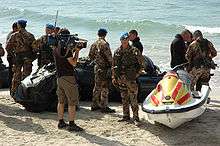
– On 25 July, two ambulances of the Lebanese Red Cross were hit by the IAF as they transported injured civilians to Tyre.[200]
– On 13 August, five civilians were killed in Burj El Shimali, amongst them three children and one Sri Lankan maid.[198]
UNIFIL troops helped with heavy bulldozers to clear debris from those bombardments.[169] Meanwhile, according to the official UN account, on the diplomatic level,
"On 11 August 2006, the Security Council, following intense negotiations, passed resolution 1701 calling for a full cessation of hostilities in the month-long war based upon, in particular, 'the immediate cessation by Hizbollah of all attacks and the immediate cessation by Israel of all offensive military operations' in Lebanon. Aware of its responsibilities to help secure a permanent ceasefire and a long-term solution to the conflict, the Security Council created a buffer zone free of 'any armed personnel, assets and weapons other than those of the Government of Lebanon and of UNIFIL' between the United Nations-drawn Blue Line in southern Lebanon and the Litani River".[169]
Still in August 2006, Italian reinforcements for UNIFIL landed in amphibian crafts on the shores of Tyre. While UNIFIL had a troops strength of about 2,000 at that point in time, the Security Council soon expanded the mandate of UNIFIL, and increased it to a maximum of 15,000 troops.[169]
Post-2006 War
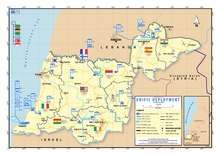
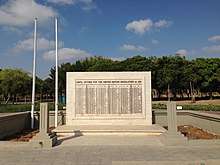
At least since 2006, Tyre city and its Southern surrounding areas have been part of the Italian UNIFIL sector, whereas its Northern surrounding areas have been part of the Korean sector.[202] UNIFIL has been assisted by UNTSO.
As UINIFIL has got a budget for small community projects as well,[203] the Italian contingent in particular has supported a variety of civil society activities with great visibility. Amongst them are efforts to preserve the archaeological heritage,[204] to assist Artistic expression and interaction,[205] to conduct medical campaigns,[206] as well as to support the children's right to play by constructing playgrounds and supporting clown therapy for children with special needs.[207]
On 9 December 2011, UNIFIL reported that one of its vehicles "traveling on a road at the southern outskirts of the city of Tyre was targeted by an explosion." Five peacekeepers of unnamed nationalities were injured and evacuated.[208]
The mayor of Tyre is Hassan Dbouk.[6] He is also the President of the Union of Municipalities of the District.[204] Dbouk has decried a lack of capacities at the local government level, while arguing that
"There is a complete absence of the central government here".[9]
In the 2018 parliamentary elections, the Tyre-Zahrani district had a 48.1% turnout out of 311,953 registered voters, but only two competing camps. The allied list of Hezbollah and Amal won all seven seats with a 92% landslide, while the one headed by Riad As'ad from the feudal dynasty of Ali al-Saghir only scored 8%.[93]
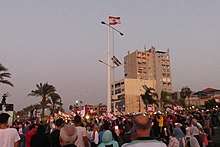
When the 2019–20 Lebanese protests against government corruption and austerity measures started across the country on 17 October 2019, masses of citizens flocked to the central Elissa Square – named after the legendary founder of Carthage – to join the nonsectarian demonstrations.[209] The venue features the highest flagpole (32.6 meters ) in all of Lebanon with a national flag of 11 X 19 meters.[210]

One day later an arson attack devastated the Rest House hotel at Tyre beach. And then another day later, as UNIFIL reported,
"a counterdemonstration by a group of armed individuals reportedly affiliated with the Amal Movement escalated into riots. The Amal Movement denied involvement."[211]
The protesters kept a tented presence inside the roundabout of Elissa Square for months. With the collapse of the Lebanese pound in the first months of 2020 they regained momentum in Tyre as across the country,[212] turning public anger over hyperinflation increasingly towards banks: in one instance, a group of protesters, closed down a bank in Tyre "as a sign of civil disobedience", after its management refused to pay out money to a customer for the medical treatment of his mother:
"Influenced by the popular drama crime Netflix series La Casa De Papel, they held the bank’s employees and manager for more than an hour as hostages."[213]
Then, in the early morning hours of April 26, three men threw Molotov cocktails towards a branch of the Credit Libanais bank, causing minor damages.[214]
On May 6, an unknown assailant fired at least eleven shots at the private home of mayor Dbouk, causing damages to the building but without hurting anyone.[215]
By 8 May 2020, the Disaster Management Unit registered 15 confirmed cases of the Coronavirus disease 2019, mostly detected amongst Lebanese repatriated from Africa.[216] Less than a month later, this number had grown to 37 cases.[217]
On May 27, Prime Minister Hassan Diab inspected the Benoit Barakat military barrack in Tyre, where he was received by LAF commander General Joseph Aoun.[218]
In late July, a young doctor who worked at Tyre’s Lebanese Italian Hospital was the first medical doctor in Lebanon to die from COVID-19.[219]
Coast Nature Reserve
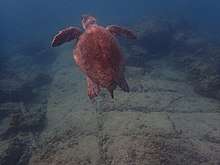
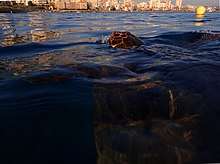
Tyre enjoys a reputation of having some of the cleanest beaches and waters of Lebanon.[16][220] However, a UN HABITAT profile found that "seawater is also polluted due to waste water discharge especially in the port area."[6] There is still also considerable pollution by solid waste.[221]
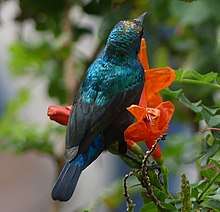
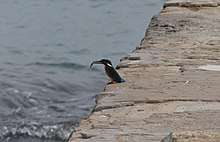
The Tyre Coast Nature Reserve (TCNR) was decreed in 1998 by the Ministry of Public Works. It is 3.5 km (2.2 mi) long and covers over 380 hectares (940 acres). The TCNR is within the best preserved stretch of sandy coastline in southern Lebanon and divided into two section zones: a 1.8-km sand lined beach, 1.8 km long and 500 meters wide-ranging from the Tyre Rest House in the north to the Rashidieh Refugee Camp in the South, and a stretch of 2 km with agriculture lands of small family farms and the springs of Ras El Ain with three constantly flowing artesian wells, ranging from Rashidieh to the village of Chaetiyeh in the South.[13]
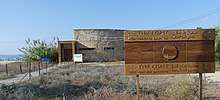
The former is divided into two zones: one for tourism that features a public beach of 900m and restaurant tents during the summer season hosting up to 20,000 visitors on a busy day, and another 900m of conservation zone as a sanctuary for sea turtles and migrating birds.[221]
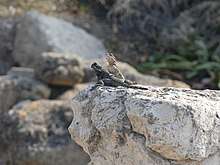
Due to its diverse flora and fauna, the reserve was designated a Ramsar Site in 1999 according to the international treaty for the conservation and sustainable use of Wetlands, since it is considered "the last bio-geographic ecosystem in Lebanon". It is an important nesting site for migratory birds, the endangered Loggerhead and green sea turtle, the Arabian spiny mouse and many other creatures (including wall lizards, common pipistrelle, and european badger).[222][223] Also, there are frequent sighting of dolphins in the waters off Tyre.[224] Altogether, the TCNR includes
"275 species distributed over 50 families. In addition, the reserve is home to seven regionally and nationally threatened species, 4 endemic and 10 rare species, whilst 59 species are restricted to the Eastern Mediterranean area. It is also worthy to indicate that, several bio-indicator species as well as 25 medicinal species were recognized. TCNR encloses flora species belonging to the various habitats: the sandy shore, rocky shore, littoral and Freshwater ecosystems. A wide number of Gramineae, Fabaceae, Asteraceae and Umbellifereae families dominate the floristic resources."[13]
However, the biodiversity of the TCNR is threatened as shown by a strong decrease in the numbers of the caspian terrapin Mauremys caspica, the green toad Bufo viridis and the tree frog Hyla savigny. Also, since the 2000s, the North American camphorweed Heterotheca subaxillaris has invaded the TCNR as a neophyte from Haifa across the Blue Line.[13] And during the 2006 war, turtle breeding areas were affected when the IDF bombed the conservation site .[225]
Cultural heritage
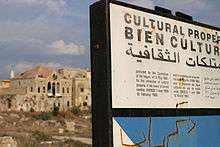
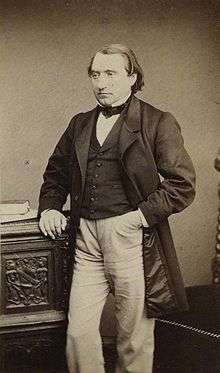
Arguably the most lasting Phoenician legacy for the Tyrian population has been the linguistic mark that the Syriac and Akkadian languages have left on the Arabic spoken in the region of Tyre.[29] Most notably, the widely used term "Ba'ali" – which is used especially to describe vegetables and fruits from rain-fed, untreated agricultural production – originates from the Baal religion.[87] The Tyrian municipality of Ain Baal is apparently also named after the Phoenician deity.[226] The most visible part of ancient and medieval history on the other side have been the archaeological sites though:
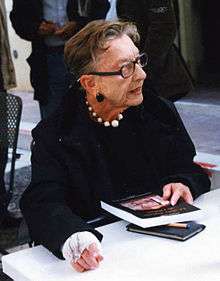
After the first archaeological excavations by Renan - who became controversial because of his racist view - and Sepp in the 1860s and 1870s respectively, more were undertaken in 1903 by the Greek archaeologist Theodore Makridi, curator of the Imperial Museum at Constantinople. Important findings like fragments of marble sarcophagi were sent to the Ottoman capital.[227]
In 1921, an archaeological survey of Tyre was done by a French team under the leadership of Denyse Le Lasseur in 1921, followed by another mission between 1934 and 1936 that included aerial surveys and diving expeditions. It was led by the Jesuit missionary Antoine Poidebard, a pioneer of aerial archaeology.[227]
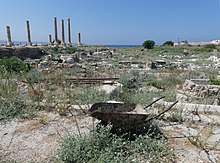
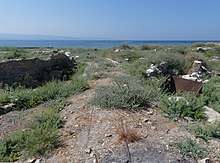
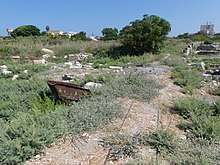
Large-scale excavations started in 1946 under the leadership of Emir Maurice Chéhab (1904-1994),[17] "the father of modern Lebanese archaeology" who for decades headed the Antiquities Service in Lebanon and was the curator of the National Museum of Beirut. His teams uncovered most remains in the Al Bass/Hippodrome and the City Site/Roman baths.[228]
During the 1960s, Honor Frost – the Cyprus-born pioneer of underwater archaeology initiated several investigations "aimed at identifying and documenting the significant archaeological potential for harbour facilities within coastal Tyre." Based on the results, she suggested that the Al Mobarakee Tower may actually date back to Hellenistic times.[23]
All those works stopped though soon after the 1975 beginning of the Civil War and many records were lost.[228]
In 1984, the United Nations Educational, Scientific and Cultural Organisation (UNESCO) declared Tyre a World Heritage Site in an attempt to halt the damage being done to the archaeological sites by the armed conflict and by anarchic urban development.[16]
In the late 1980s, "clandestine excavations" took place in the Al-Bass cemetery which "flooded the antiquities market".[20]
Regular excavation activities only started again in 1995 under the supervision of Ali Khalil Badawi.[67] Shortly afterwards, an Israeli bomb destroyed an apartment block in the city and evidence for an early church was revealed underneath the rubble. Its unusual design suggests that this was the site of the Cathedral of Paulinus which had been inaugurated in 315 CE[229]
In 1997, the first Phoenician cremation cemetery was uncovered in the Al Bass site, near the Roman necropolis.[26] Meanwhile, Honor Frost mentored local Lebanese archaeologists to conduct further underwater investigations, which in 2001 confirmed the existence of a man-made structure within the northern harbour area of Tyre.[23]
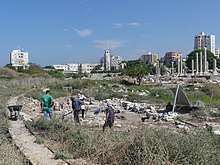
The hostilities of the 2006 Lebanon War put the ancient structures of Tyre at risk. This prompted UNESCO's Director-General to launch a "Heritage Alert" for the site.[230] Following the cessation of hostilities in September 2006, a visit by conservation experts to Lebanon observed no direct damage to the ancient city of Tyre. However, bombardment had damaged frescoes in a Roman funerary cave at the Tyre Necropolis. Additional site degradation was also noted, including "the lack of maintenance, the decay of exposed structures due to lack of rainwater regulation and the decay of porous and soft stones".[231]
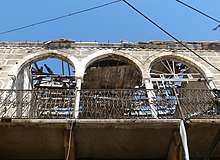
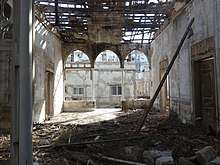

Since 2008, a Lebanese-French team under the direction by Pierre-Louis Gatier of the University of Lyon has been conducting archaeological and topographical work. When international archeological missions in Syria came to a halt after 2012 due to the war there, someof them instead started excavations in Tyre, amongst them a team headed by Leila Badre, director of the Archeological Museum of the American University of Beirut (AUB), and Belgian archaeologists.[228] Threats to Tyre's ancient cultural heritage include development pressures and the illegal antiquities trade.[232] A highway, planned for 2011, was expected to be built in areas that are deemed archaeologically sensitive. A small-scale geophysical survey indicated the presence of archaeological remains at proposed construction sites. The sites have not been investigated. Despite the relocation of a proposed traffic interchange, the lack of precise site boundaries confuses the issue of site preservation.[231]
A 2018 study of Mediterranean world heritage sites found that Tyre's City site has "the highest risk of coastal erosion under current climatic conditions, in addition to 'moderate' risk from extreme sea levels."[233]
Like many of the cities in the Levant and in Lebanon, the architecture since the Lebanese Civil War in the 1970s has been of poor quality, which tend to threaten the cultural heritage in the built environment before the war. Meanwhile, historical buildings from the Ottoman period like Khan Rabu and Khan Sour / Khan Ashkar have partly collapsed after decades of total neglect and lack of any maintenance whatsoever.
In 2013, the International Association to Save Tyre (IAST) made headlines when it launched an online raffle in association with Sotheby's to fund the artisans’ village "Les Ateliers de Tyr" at the outskirts of the city. Participants could purchase tickets for 100 Euros to win the 1914 ‘Man with Opera Hat’ painting by Pablo Picasso.[234] The proceeds totaled US$5.26 million. The painting was won by a 25-year-old fire-safety official from Pennsylvania.[235] IAST president Maha El-Khalil Chalabi is the daughter of feudal lord and politician Kazem el-Khalil.[136]
Scriptural

The Bible makes several references to Tyre:
- According to Joshua 19:29, Tyre is referred to as a "strong city," and was allotted to the Tribe of Asher.
- King Hiram I was a contemporary of David and Solomon in 2 Samuel 5:11, 1 Kings 5:1, and 1 Chronicles 14:1.
- Tyre is mentioned in the Book of Isaiah (Isaiah 23), the Book of Jeremiah (Jer 25:22, Jer 47:4), the Book of Ezekiel (Ezekiel 26–28), the Book of Joel (Joel 3:4–8), the Book of Amos (Amos 1:9–10), the Psalms, and the Book of Zechariah (Zechariah 9:3–4), which prophesied its destruction.
- Jesus visited the region or "coasts" (King James Version) of Tyre and Sidon (Matthew 15:21; Mark 7:24) and from this region many came forth to hear him preaching (Mark 3:8; Luke 6:17), leading to the stark contrast in Matthew 11:21–23 to his reception in Korazin and Bethsaida.
- In the Book of Revelation, Revelation 18 alludes extensively to the mercantile description of Tyre in Ezekiel 26–28.
Other writings
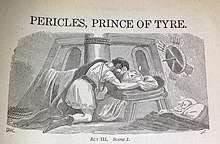
- Apollonius of Tyre is the subject of an ancient short novella, popular in the Middle Ages. Existing in numerous forms in many languages, the text is thought to be translated from an ancient Greek manuscript, now lost.
- Pericles, Prince of Tyre is a Jacobean play written at least in part by William Shakespeare and George Wilkins. It is included in modern editions of his collected works despite questions over its authorship.
- In 19th-century Britain, Tyre was several times taken as an exemplar of the mortality of great power and status, for example by John Ruskin in the opening lines of The Stones of Venice and by Rudyard Kipling's Recessional.
- Tyrus is the title and subject of a poem by the Cumbrian poet Norman Nicholson in his collection 'Rock Face' of 1948.
- The French comic book artist Albert Uderzo published in 1981 Asterix and the Black Gold which describes Asterix's and Obelix's voyage to the Middle East featuring James Bond and biblical themes: in their quest for petroleum they sail on board a Phoenician ship, but the Roman regime closes off the ports of Tyre in order to deny their landing.
- In 2015, the French-Lebanese artist Joseph Safieddine published the graphic novel drama Yallah Bye which offers an account of his family's fate during the 2006 war between Israel and Hizbollah, when they sought refuge in the Christian quarter of Tyre. An English version followed in 2017 and an Arabic one in 2019.
Cultural life
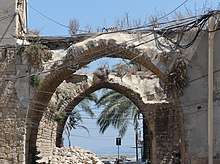
The first cinema in Tyre opened in the late 1930s when a café owner established makeshift film screenings.[236] Hamid Istanbouli – a fisherman by profession, who was also a traditional storyteller (hakawati) and thus interested in cinema – projected films on the wall of a Turkish hammam.[237] In 1939 the Roxy opened, followed in 1942 by the "Empire".[238]
"By the mid-1950s there were four cinemas in Tyre, and four more soon opened in nearby Nabatieh. Many also hosted live performances by famous actors and musicians, serving as community spaces where people from different backgrounds came together."[236]
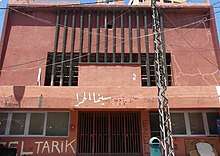
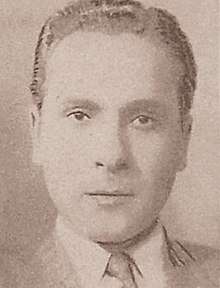
In 1959, the "Cinema Rivoli of Tyre" opened and quickly became one of the prime movie theatres of the country. According to UNIFIL, it was visited "by celebrity who's whos of the time, including Jean Marais, Brigitte Bardot, Rushdi Abaza and Omar Hariri."[239] In 1964, the "Dunia" opened,[240] two years later followed by the "Al Hamra Cinema",[238] which became a venue for some of the Arab world's most famous performers, like Mahmoud Darwish, Sheikh Imam, Ahmed Fouad Negm, Wadih el-Safi, and Marcel Khalife.[236]

Meanwhile, two Tyrian artists had a major impact on the development of Lebanese music: Halim el-Roumi (1919–1983) and Ghazi Kahwaji (1945–2017). Some sources claim that the famous musician, composer, singer and actor el-Roumi was born in Tyre to Lebanese parents. However, others suggest that he was born in Nazareth and moved to Tyre from Palestine.[241] For some time, he worked as a teacher at the Jafariya High School there. In 1950 he became director of Radio Lebanon's music department,[242] where he discovered the singer Fairuz and introduced her to the Rahbani brothers.[243] Roumi composed music for and with them in close collaborations.[244]
Kahwaji was Lebanon's first scenographer and for three decades the artistic general director for the Rahbani brothers and Fairuz. He used this prominent position to promote "against confessionalism and fundamentalism". Between 2008 and 2010 he published the sarcastic three-volume book series "Kahwajiyat" about social injustice in the Arab world.[245]
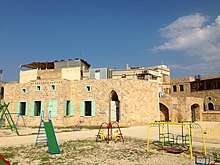
By then, cultural life in Tyre had been severely affected by armed conflict as well. In 1975, the commercial "Festivals de Tyr" – which had been founded in 1972 by Maha al-Khalil Chalabi, the daughter of feudal landlord and politician Kazem al-Khalil – was stopped at the outbreak of the Civil War in 1975.[246] Some cinemas were damaged by Israeli bombardment in 1982 and all of them eventually closed down, the last ones in 1989:[236] the Hamra and the AK2000.[238]
In the mid-nineties though, first the commercial "Festivals de Tyr" were revived and have been organised since then annually in the ancient site of the Roman hippodrome, featuring international artists like Elton John and Sarah Brightman,[247] as well as Lebanese stars Wadie El Safi, Demis Roussos, Kadim Al-Saher, Melhem Barakat, Julia Boutros, and Majida El Roumi,[87] daughter of Halim el-Roumi. The pop-singer Layal Abboud was born and raised in the Tyrian village of Kniseh. She has returned occasionally to perform in Tyre as well.
In 2006, the "Centre de Lecture et d’Animation Culturelle" (C.L.A.C.) was opened by Tyre's municipality as the first public library of the city, with support from the Lebanese Ministry of Culture and the French Embassy in Beirut. It is located in the historical building of the "Beit Daoud" next to the "Beit El Medina" in the old town.[248]
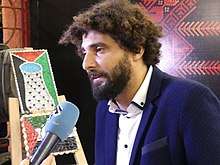
In 2014, the NGO Tiro Association for Arts rehabilitated the defunct cinema Al Hamra under the leadership of "Palestinian-Lebanese street theater performer, actor, comedian, and theater director"[249] Kassem Istanbouli (*1986). His grandfather was one of the founders of cinema in Tyre and his father used to repair cinema projectors.[237] The Tiro Association launched the Lebanese International Theater Festival (alternating for storytelling, contemporary dance, and women monodrama), the Lebanese International Short film Festival, the Tyre International Music Festival, the Palestinian Culture Festival, Tiro Arts Festival, and a number of other festivals. In 2018, the Istanbouli Theatre troupe rehabilitated and moved to the Rivoli Cinema,[250] which had been closed since 1988,[251] to establish the non-commercial Lebanese National Theater as a free cultural space with free entrance and a special focus on training children and youth in arts. It also runs the "Mobile Peace Bus", which is decorated with graffiti of Lebanese cultural icons, to promote arts in the villages of the neighbouring countryside.[252] Istanbouli has argued:
“In Tyre, we have 400 shops for shisha, one library, and one theatre. But if there are places, people will come."[253]
In 2019, the film "Manara" (Arabic for lighthouse) by Lebanese director Zayn Alexander, who shot the movie at the Al Fanar resort in Tyre, won the Laguna Sud Award for Best Short Film at the Venice Days strand festival.[254]
Education
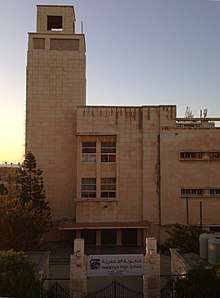
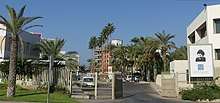
The Jafariya School was founded in 1938 by Imam Abdul Hussein Sharafeddin.[85] It soon expanded thanks mainly to donations from rich émigrés and thus was upgraded in 1946 to be a Secondary School, the first in Southern Lebanon (see above). It has remained one of the main schools in Tyre ever since.[107]
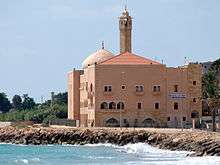
An important role in the Tyrian education landscape is played by the charity organisation of the vanished Imam Musa Sadr, which has been headed since his disappearance in 1978 by his sister Rabab al-Sadr.[255] While the foundation operates in various parts of the country, its main base is a compound on the southern entry of the Tyre peninsula close to the sea. A major focus are its Orphanages, but it also runs adult educational and vocational training programmes, especially for young women, in addition to health and development projects.[256]
Musa Sadr also laid the groundwork for establishing the Islamic University of Lebanon (IUL) which was finally licensed in 1996 and opened a branch in Tyre. Its Board of Trustees is dominated by representatives of the Supreme Shiite Council, founded by Sadr in 1967.[257]
The Lebanese Evangelical School in Tyre with a history of more than 150 years is arguably the largest school in town. Collège Élite, a French international school opened in 1996, is another one of a host of private schools in Tyre. The Cadmous College - a pre-kindergarten to grade 12 school, run by the Maronite missionaries - has about 10% Christian and 90% Muslim pupils.[258]
In August 2019, the 17-year-old Ismail Ajjawi – a Palestinian resident of Tyre and graduate of the UNRWA Deir Yassin High School in the El Bass refugee camp[259] – made global headlines when he scored top-results to earn a scholarship to study at Harvard, but was deported upon arrival in Boston despite valid visa.[260] He was readmitted ten days later to start his studies in time.[261]
Demographics
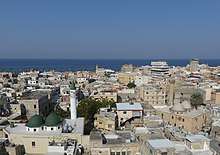
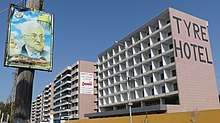
An accurate statistical accounting is not possible, since the government of Lebanon has released only rough estimates of population numbers since 1932.[262] However, a 2016 calculation by UN HABITAT estimated a figure of 201,208 inhabitants, many of them refugees:[6]
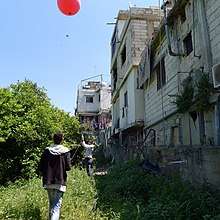
The city of Tyre has become home to more than 60,000 Palestinian refugees who are mainly Sunni Muslim. As of June 2018, there were 12,281 registered persons in the Al Buss camp,[119] 24,929 in Burj El Shimali[129] and 34,584 in Rashidieh.[118] In the ramshackle "gathering" of Jal Al Bahar next to the coastal highway, the number of residents was estimated to be around 2,500 in 2015.[130]
In all camps, the number of refugees from Syria and Palestinian refugees from Syria increased in recent years.[118] Tensions developed since these new arrivals would often accept work in the citrus and banana groves "for half the daily wage" that local Palestinian refugees used to earn.[263]
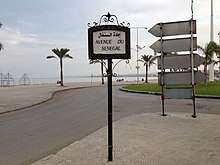
In early 2019, some 1.500 Syrian refugees were evicted from their informal settlements around the Litani river for allegedly polluting the waters which are already heavily contaminated.[264]
The Lebanese nationality population of Tyre is predominantly Shia Muslim with a small but noticeable Christian community. In 2010, it was estimated that Christians accounted for 15% of Tyre's population.[265] In 2017, the Maronite Catholic Archeparchy of Tyre counted about 42,500 members. Most of them live in the mountains of Southern Lebanon, while there are just some 500 Maronites in Tyre itself. The Melkite Greek Catholic Archeparchy of Tyre – which not only covers the District of Tyre in the South Governorate but also neighbouring areas in the Nabatieh Governorate – registered 2,857 members in that year.[266]
Tyre is known as "Little West Africa". Many families in Tyre have relatives in the Western Africa diaspora, especially in Senegal, Sierra Leone, Liberia, Ivoy Coast and Nigeria. In Senegal, most immigrants originated from Tyre. Member of the Tyrian communities there are "primarily second-, third-, and fourth-generation migrants, many of whom have never been to Lebanon." One of Tyre's main promenades is called "Avenue du Senegal".[107]
As there were an estimated 250,000 foreign workers – mostly female Ethiopians – under the discriminatory Kafala system of sponsorship in Lebanon by 2019,[267] there is also a large community of African migrants in Tyre. They are mainly Ethiopian women who work as domestic servants. Some of them celebrate church service at the Greek-Catholic Cathedral of Saint Thomas, which has devoted a chapel on its compound to Tyre-born Saint Frumentius, the first bishop of the Ethiopian Orthodox Tewahedo Church. In April 2014 one Ethiopian made sad headlines in an apparent suicide in Tyre:
"Media reports said the woman had fled last week from her employer’s home. Security forces later detained the Ethiopian and returned her to her employer."[268]
The 2016 UN HABITAT profile found that
"Approximate calculations suggest that 43% of Lebanese in Tyre urban area are living in poverty."[6]
Economy
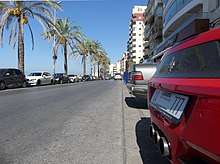
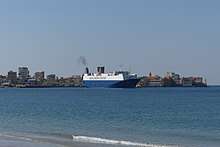
The economy of urban Tyre mostly depends on tourism, contracting services, the construction sector, and remittances from Tyrians in the diaspora, especially in West Africa.[6]
UNIFIL contributes greatly to the purchasing power in the Tyrian economy as well, both through spending by its individual members as well as through "quick-impact projects" like gravelling road, rehabilitating public places etc.[9]
As of 2016, Olive trees were reported to comprise 38% of Tyre's agricultural land, but producers lacked a collective marketing strategy. While Citrus reportedly comprised 25% of the agricultural land, 20% of its harvest ended up wasted.[132]
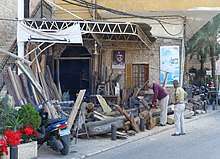
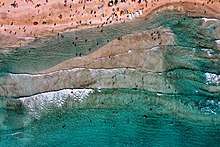
Tyre houses one of the nation's major ports, though much smaller than the ports of Beirut, Tripoli and also Sidon/Saida. Its cargo traffic has been limited to the periodical import of used cars. One day after the 2020 Beirut explosion which devastated the Port of Beirut and much of the national capital on 4 August the national government reportedly decided to use the Port of Tyre as a back-up for the Port of Tripoli.[269]
In the harbour area the Barbour family of shipmakers continues to build wooden boats.[47] Tyre is thus one of only a few cities in the Mediterranean that has kept this ancient tradition, although the Barbour business has been struggling to survive as well. By 2004, there were "over 600 fishermen [..] striving to make ends meet in Tyre alone".[270]
Lebanon's General Directorate of Land Registry and Cadastre (GDLRC) recorded for Tyre a 4.4 percent growth rate for land transactions between 2014 and 2018, the highest rate in the country during that period.[271] This increase in real estate prices has been largely attributed to the inflow of remittances from diaspora Tyrians.[6]
Off the Tyrian coast, block 9 has been awarded for deepwater drilling of natural gas to a consortium of French company Total S.A., Italy-based Eni, and Russian Novatek.[272]
Sports
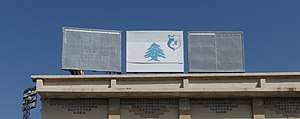
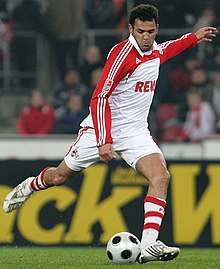

Tadamon Sour Sporting Club, or simply Tadamon (meaning "Solidarity"), nicknamed "The Ambassador of the South", was founded in 1946 and is thus the historically most established football club of Tyre. They play their home matches at the Tyre Municipal Stadium, and have won one Lebanese FA Cup (2000–01) and two Lebanese Challenge Cups (2013 and 2018). Tadamon's traditional rivals, Salam Sour Sports Club, are also based in Tyre.
According to BBC reports, Tadamon SC was stripped of its Lebanese Premier League championship title in 2001 following match-fixing allegations.[273]
In the same year the club scored arguably one of its biggest transfers when Roda Antar from its own youth teams was loaned to Germany's Hamburger SV for two seasons. After eight years in Germany with Hamburg, SC Freiburg and 1. FC Köln he played another six years in the Chinese Super League and then returned to Tadamon for one final season before retirement.
A number of Lebanese Premier League professional footballers, who have also played for the Lebanon national team, originate from Tyre, namely Rabih Ataya,[274] and Nassar Nassar.[275]
Galleries
Antiquities sites
Al Mina
Al Bass
The Islamic quarter of the Old Town (Harat El Islem)
The Old Mosque
The Abdul Hussein Mosque
Khan Rabu
The Christian Quarter (Harat El Masihiye)
Fishing Harbour
Beit Albert Wakim
Al Mobarakee Tower
Al Manara lighthouse
Greek-Orthodox Saint Thomas church
Greek Catholic (Melkite) Archeparchy Saint Thomas cathedral
Sisters of St. Joseph of the Apparition
Franciscan Latin-Catholic Terra Santa church
The Christian cemetery (Makbarat el-Masihiye)
Twin towns – sister cities
Tyre is twinned with:
Notable people
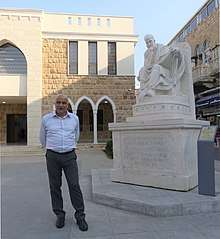
- Antipater of Tyre (1st century BCE), Stoic philosopher
- Apollonius of Tyre (philosopher) (c. 50 BCE), philosopher
- Belus King of Tyre in the Aeneid
- Ulpian (early 3nd century CE), Roman jurist
- Diodorus of Tyre (late 2nd century BCE), Peripatetic philosopher
- Meropius of Tyre (Μερόπιος), a philosopher , traveled together with two of his relatives, Frumentius (Φρουμέντιος) and Edesius (Εδέσιος) to ancient India.[277][278]
- Dido, founder-heroine of Carthage
- Saint Christina of Tyre (3rd century CE) Martyr[279]
- Hiram I, Biblical King of Tyre
- Porphyry, Neoplatonic philosopher and writer
- Pygmalion of Tyre, King of Tyre
- William of Tyre, (12th century CE), historian and Archbishop of Tyre
- Abdel Hussein Sharafeddine, Shi'a reformer
- Musa Sadr, Shi'a leader
- Halim el-Roumi, singer and composer
- Ghazi Kahwaji, scenographer and writer
- Nabih Berri, leader of the Amal movement
- As'ad AbuKhalil, anarchist and professor of political science at California State University, Stanislaus
- Zaki Chehab, founder and editor-in-chief of ArabsToday.net
- Alaa Zalzali, singer
- Joe Barza, chef and television personality
- Périhane Chalabi Cochin, TV host
- Rabih Ataya, Lebanese football player[274]
- Nassar Nassar, Lebanese football player[275]
Astronomical objects
A multi-ring structured region on Europa, the smallest of the four Galilean moons orbiting Jupiter, is named after Tyre, the legendary birthplace of princess Europa. Originally called "Tyre Macula", it is some 140 kilometers in diameter (about the size of the island of Hawaii) and thought to be the site where an asteroid or comet impacted Europa's ice crust.[280]
The asteroid 209 Dido is named after the legendary Tyrian-Carthaginian princess. It is a very large main-belt asteroid, classified as a C-type asteroid which is probably composed of carbonaceous materials. 209 Dido was discovered in 1879 by C. H. F. Peters.
See also
References
- "The world's 20 oldest cities". The Telegraph. 30 May 2017. Retrieved 25 March 2020.
- "World Heritage List: Tyre". United Nations Educational, Scientific and Cultural Organization. 2020. Retrieved 13 March 2020.
- Medlej, Youmna Jazzar; Medlej, Joumana (2010). Tyre and its history. Beirut: Anis Commercial Printing Press s.a.l. pp. 1–30. ISBN 978-9953-0-1849-2.
- Finlay, Victoria (2014). Colour: Travels Through the Paintbox. London: Hachette UK. ISBN 9780340733295.
- Tyre City, Lebanon
- Maguire, Suzanne; Majzoub, Maya (2016). Osseiran, Tarek (ed.). "TYRE CITY PROFILE" (PDF). reliefweb. UN HABITAT Lebanon. pp. 12, 16, 33–34, 39–43, 57, 72. Retrieved 29 October 2019.
- Presutta, David. The Biblical Cosmos Versus Modern Cosmology. 2007, page 225, referencing: Katzenstein, H.J., The History of Tyre, 1973, p.9
- Badawi, Ali Khalil (2018). TYRE (4th ed.). Beirut: Al-Athar Magazine. pp. 5, 7.
- "Ten ways to develop southern Lebanon". The New Humanitarian. 15 February 2013. Retrieved 4 December 2019.
- Woodhouse, Robert (2004). "The Greek Prototypes of the City Names Sidon and Tyre: Evidence for Phonemically Distinct Initials in Proto-Semitic or for the History of Hebrew Vocalism?". Journal of the American Oriental Society. 124 (2): 237–248. doi:10.2307/4132213. JSTOR 4132213.
- Bikai, P., "The Land of Tyre", in Joukowsky, M., The Heritage of Tyre, 1992, chapter 2, p. 13
- "Tyre". Collins Dictionary. Retrieved 21 October 2019.
- Yacoub, Adel; El Kayem, Cynthia; Moukaddem, Tala (15 September 2011). "Information Sheet on Ramsar Wetlands (RIS)–2009-2012version" (PDF). Ramsar Sites Information Service. Retrieved 15 March 2020.
- Brown, Sally (16 October 2018). "University research shows world heritage sites under threat from climate change". University of Southampton. Retrieved 18 March 2020.
- Jidejian, Nina (2018). TYRE Through The Ages (3rd ed.). Beirut: Librairie Orientale. pp. 39–58. ISBN 9789953171050.
- Carter, Terry; Dunston, Lara; Jousiffe, Ann; Jenkins, Siona (2004). lonely planet: Syria & Lebanon (2nd ed.). Melbourne: Lonely Planet Publications. pp. 345–347. ISBN 1-86450-333-5.
- Jidejian, Nina (2018). TYRE Through The Ages (3rd ed.). Beirut: Librairie Orientale. pp. 13–17. ISBN 9789953171050.
- Bement, R B. Tyre; the history of Phoenicia, Palestine and Syria, and the final captivity of Israel and Judah by the Assyrians. Ulan Press. p. 47. ASIN B009WP2MR8.
- Khoury Harb, Antoine Emile (2017). History of the Lebanese Worldwide Presence – The Phoenician Epoch. Beirut: The Lebanese Heritage Foundation. pp. 33–34, 44–49. ISBN 9789953038520.
- Abousamra, Gaby; Lemaire, André (2013). "Astarte in Tyre According to New Iron Age Funerary Stelae". Die Welt des Orients. Vandenhoeck & Ruprecht (GmbH & Co. KG). 43, H. 2 (2): 153–157. doi:10.13109/wdor.2013.43.2.153. JSTOR 23608852.
- Khoury Harb, Antoine Emile (2017). History of the Lebanese Worldwide Presence – The Phoenician Epoch. Beirut: The Lebanese Heritage Foundation. pp. 74–137. ISBN 9789953038520.
- La Boda, Sharon (1994). International Dictionary of Historic Places: Middle East and Africa. 4. Chicago and London: Fitzroy Dearborn. p. 711. ISBN 1-884964-03-6.
- Noureddine, Ibrahim; Mior, Aaron (2018). "Archaeological Survey of the Phoenician Harbour at Tyre, Lebanon". Bulletin d'Archeologie et d'Architecture Libanaises. 18: 95–112 – via Academia.edu.
- Jidejian, Nina (2018). TYRE Through The Ages (3rd ed.). Beirut: Librairie Orientale. pp. 278–304. ISBN 9789953171050.
- Bariaa Mourad. "Du Patrimoine à la Muséologie : Conception d'un musée sur le site archéologique de Tyr",(Thesis); Museum National d'Histoire Naturelle (MNHN), Study realised in cooperation with the Unesco, Secteur de la Culture, Division du Patrimoine Culturel, Paris, 1998
- A visit to the Museum... The short guide of the National Museum of Beirut, Lebanon. Beirut: Ministry of Culture/Directorate General of Antiquities. 2008. pp. 37, 39, 49, 73, 75. ISBN 978-9953-0-0038-1.
- Vance, Donald R. (March 1994) "Literary Sources for the History of Palestine and Syria: The Phœnician Inscriptions" The Biblical Archaeologist 57(1), pp. 2–19
- Morris, Robert (1876). Freemasonry in the Holy Land: Or, Handmarks of Hiram's Builders (10th ed.). Chicago: Knight & Leonard. pp. 35, 93, 95, 97.
- Mroue, Youssef (2010). Highlights of the Achievements and Accomplishments of the Tyrian Civilization And Discovering the lost Continent. Pickering. pp. 9–34.
- Gubel, Éric (1983). Gubel, Éric; Lipinski, Edward; Servais-Soyez, Brigitte (eds.). Art in Tyre in the First and Second Iron Age. Redt Tyrus/Sauvons Tyr: Histoire phénicienne/Fenincische Geschiedenis. Leuven: Peeter. pp. 23–52. ISBN 9789070192136.
- Jidejian, Nina (2018). TYRE Through The Ages (3rd ed.). Beirut: Librairie Orientale. pp. 57–99. ISBN 9789953171050.
- Aubet, María Eugenia (2013). Steiner, Margreet L.; Killebrew, Ann E. (eds.). Phoenicia during the Iron Age II period. The Oxford Handbook of the Archaeology of the Levant c.8000–332 BCE. Oxford: Oxford University Press. pp. 709–714. ISBN 978-0199212972.
- Krause, Günter (1985). Begleitheft zur Ausstellung Tyros, Hafenstadt Phöniziens. Duisburg-Ruhrort: Museum der Deutschen Binnenschifffahrt. pp. 1–5, 12–14.
- Herodotus (17 April 2008). The Histories. Oxford World's Classics. p. 137. ISBN 9780199535668.
- from 'Tyre' in Easton's Bible Dictionary
- "Founding of Carthage". Livius.org. Retrieved 13 May 2020.
- Bement, R B. Tyre; the history of Phoenicia, Palestine and Syria, and the final captivity of Israel and Judah by the Assyrians. Ulan Press. p. 48. ASIN B009WP2MR8.
- Jidejian, Nina (2018). TYRE Through The Ages (3rd ed.). Beirut: Librairie Orientale. pp. 107–117. ISBN 9789953171050.
- Badawi, Ali Khalil (2018). TYRE (4th ed.). Beirut: Al-Athar Magazine. p. 133.
- Katzenstein, H. Jacob (1979). "Tyre in the early Persian period (539-486 B.C)". The Biblical Archaeologist. 42 (1): 23–34. doi:10.2307/3209545. JSTOR 3209545.
- Herodotus. The Histories, Book 2. pp. 115 §44.
- Jidejian, Nina (2018). TYRE Through The Ages (3rd ed.). Beirut: Librairie Orientale. pp. 119–141. ISBN 9789953171050.
- Robin Lane Fox, Alexander the Great 1973:181f.
- "Strolling in old Tyr – LebanonUntravelled.com". Retrieved 13 February 2019.
- 315 B.C. – events and references
- 314 B.C. – events and references
- Zoghaib, Henri (2004). lebanon – THROUGH THE LENS OF MUNIR NASR. Beirut: Arab Printing Press sal. p. 74. ISBN 9789953023854.
- "Tyre (3)". Livius.org. 2012. Retrieved 27 February 2020.
- 126 B.C. – events and references
- "Demetrius Nicator, King of Syria, Killed as He Attempts to Land at Tyre". The J. Paul Getty Museum. Retrieved 8 January 2020.
- Badawi, Ali Khalil (2018). TYRE (4th ed.). Beirut: Al-Athar Magazine. pp. 33, 76.
- 64 B.C. – events and references
- E. G. Hardy, Roman Laws and Charters, New Jersey 2005, p.95
- Jidejian, Nina (2018). TYRE Through The Ages (3rd ed.). Beirut: Librairie Orientale. pp. 142–169. ISBN 9789953171050.
- Jidejian, Nina (2011). Lebanon, a Journey Through Time. Beirut: Librairie Orientale. p. 106.
- Jidejian, Nina (2018). TYRE Through The Ages (3rd ed.). Beirut: Librairie Orientale. pp. 19–37. ISBN 9789953171050.
- Josephus, Wars of the Jews (ii.xviii.§1; iv.ii.§3)
- Josephus, Wars of the Jews (iii.iii.§1)
- Josephus, De Bello Judaico (Wars of the Jews III, 35 (Wars of the Jews 3.3.1)
- Badawi, Ali Khalil (2018). TYRE (4th ed.). Beirut: Al-Athar Magazine. pp. 94, 103–121.
- Hirt, Alfred (2015). Mac Sweeney, Naoíse (ed.). Beyond Greece and Rome: Foundation Myths on Tyrian Coinage in the Third Century AD. Foundation Myths in Ancient Societies: Dialogues and Discourses. Philadelphia: University of Pennsylvania Press. pp. 191–226. ISBN 978-0812246421.
- Video showing the Roman hippodrome of Tyre
- Khoury Harb, Antoine Emile (2017). History of the Lebanese Worldwide Presence – The Phoenician Epoch. Beirut: The Lebanese Heritage Foundation. p. 166. ISBN 9789953038520.
- "500 Martyrs of Tyre". Living Maronite. 19 February 2017. Retrieved 8 October 2019.
- Gatier, Pierre-Louis (2011). Gatier, Pierre-Louis; Aliquot, Julien; Nordiguian, Lévon (eds.). Sources de l'histoire de Tyr. Textes de l'Antiquité et du Moyen Âge (PDF). Tyr l'instable : pour un catalogue des séismes et tsunamis de l'Antiquité et du Moyen Âge (in French). Beirut: Co-édition Presses de l'Ifpo / Presses de l'Université Saint-Joseph. p. 263. ISBN 978-2-35159-184-0.
- Doig, Allan (2008). Liturgy and Architecture from the Early Church to the Middle Ages. Ashgate Publishing, Ltd. pp. 24. ISBN 9780754652748.
- Badawi, Ali Khalil (2018). TYRE (4th ed.). Beirut: Al-Athar Magazine. pp. 62, 74, 102.
- Freestone, Ian; Jennings, Sarah; Aldsworth, Fred; Haggerty, George; Whitehouse, David B. (2001). "The Glass-Making Area on the Island Site at Tyre, Southern Lebanon". Bulletin d'Archeologie et d'Architecture Libanaises (BAAL). MINISTÈRE DE LA CULTURE, Direction Générale des Antiquitiés. 5: 219–239 – via Academia.edu.
- Gil, Moshe (1997) [1983]. A History of Palestine, 634–1099. Translated by Ethel Broido. Cambridge: Cambridge University Press. pp. 369–370. ISBN 0-521-59984-9.
- Harris, William (2012). Lebanon: A History, 600–2011. Oxford: Oxford University Press. pp. 48, 53, 67. ISBN 978-0195181111.
- Smit, Ferdinand (2006). The battle for South Lebanon: Radicalisation of Lebanon's Shi'ites 1982–1985 (PDF). Amsterdam: Bulaaq, Uitgeverij. pp. 23, 36, 61–62, 71, 90, 115, 127–128, 133–134, 152, 164, 175, 183, 220, 269–274, 297–298, 300. ISBN 978-9054600589.
- Jidejian, Nina (2018). TYRE Through The Ages (3rd ed.). Beirut: Librairie Orientale. pp. 248–271. ISBN 9789953171050.
- Dajani-Shakeel, Hadia (1993). Shatzmiller, Maya (ed.). Diplomatic Relations Between Muslim and Frankish Rulers 1097–1153 A.D. Crusaders and Muslims in Twelfth-Century Syria. Leiden, New York, Cologne: Brill. p. 206. ISBN 978-90-04-09777-3.
- Jacoby, David (2016). Boas, Adrian J. (ed.). The Venetian Presence in the Crusader Lordship of Tyre: a Tale of Decline. The Crusader World. New York: Routledge. pp. 181–195. ISBN 978-0415824941.
- Runciman, Steven (1987). A History of the Crusades. 3. Cambridge: Cambridge University Press. pp. 283, 353. ISBN 0521347726.
- Hillenbrand, Carole (1999). The Crusades: Islamic Perspectives. Edinburgh: Edinburgh University Press. pp. 398, 470–471. ISBN 978-0748606306.
- Schulze, Kirsten E. (2009). The Jews of Lebanon: Between Coexistence and Conflict (2nd ed.). Brighton / Portland: Sussex Academic Press. pp. 13–15, 110 (plate 20). ISBN 978-1845190576.
- Altaner, Jan (2019). "Deutsche Spuren im Libanon: Auf den Spuren Barbarossas – Deutsche Kaiser-Gebeine in Tyros?". GOETHE INSTITUT LIBANON (in German). Retrieved 24 September 2019.
- Piana, Mathias (2016). "Crusader fortifications: between tradition and innovation". In Boas, Adrian J. (ed.). The Crusader World. New York: Routledge. pp. 437–459. ISBN 978-0415824941.
- Folda, Jaroslav (2005). Crusader Art in the Holy Land, From the Third Crusade to the Fall of Acre. Cambridge: Cambridge University Press. p. 105. ISBN 978-0521835831.
- Holt, Peter Malcolm (1995). Early Mamluk Diplomacy, 1260–1290: Treaties of Baybars and Qalāwūn with Christian Rulers. Leiden / New York / Köln: E.J. Brill. pp. 106–117. ISBN 978-9004102460.
- Redding, Moses Wolcott (1875). Antiquities of the Orient unveiled, containing a concise description of the remarkable ruins of King Solomon's temple, and store cities, together with those of all the most ancient and renowned cities of the East, including Babylon, Nineveh, Damascus, and Shushan (PDF). New York: Temple Publishing Union. pp. 145, 154.
- Shanahan, Rodger (2005). The Shi'a of Lebanon – The Shi'a of Lebanon Clans, Parties and Clerics (PDF). LONDON • NEW YORK: TAURIS ACADEMIC STUDIES. pp. 16, 41–42, 46–48, 80–81, 104. ISBN 9781850437666.
- Jidejian, Nina (2018). TYRE Through The Ages (3rd ed.). Beirut: Librairie Orientale. pp. 265, 272. ISBN 9789953171050.
- Gharbieh, Hussein M. (1996). Political awareness of the Shi'ites in Lebanon: the role of Sayyid 'Abd al-Husain Sharaf al-Din and Sayyid Musa al-Sadr (PDF) (Doctoral). Durham: Centre for Middle Eastern and Islamic Studies, University of Durham.
- Jaber, Kamel (2005). MEMORY OF THE SOUTH. Beirut: SOUTH FOR CONSTRUCTION. pp. 94, 96–97.
- Badawi, Ali Khalil (2008). Tyr - L'histoire d'une Ville. Tyre/Sour/Tyr: Municipalité de Tyr / Tyre Municipality / Baladia Sour. pp. 80–103.
- Bayeh, Joseph (2017). A History of Stability and Change in Lebanon: Foreign Interventions and International Relations. London / New York: I.B.Tauris. pp. 19–20, 33. ISBN 978-1784530976.
- Sepp, Johann Nepomuk (1879). Meerfahrt nach Tyros zur Ausgrabung der Kathedrale mit Barbarossa's Grab. Leipzig: Verlag von E.A. Seemann. pp. 112–113, 247.
- Gorton, Ted (2014). Renaissance Emir: A Druze Warlord at the Court of the Medici. London: Olive Branch Pr. pp. 66, 104, 156–157. ISBN 978-1566569637.
- Badawi, Ali Khalil (2018). TYRE (4th ed.). Beirut: Al-Athar Magazine. pp. 46–49.
- Winter, Stefan (2010). The Shiites of Lebanon under Ottoman Rule, 1516–1788. Cambridge: Cambridge University Press. pp. 126, 129–134, 140, 177–178. ISBN 9780521765848.
- Jouhari, Ibrahim (13 September 2019). "The By-elections that was not!". 128 Lebanon. Retrieved 27 November 2019.
- Suttner, Ernst Christoph (n.d.). "Wann und wie kam es zur Union von Melkiten mit der Kirche von Rom?" (PDF). Zentrum St. Nikolaus für das Studium der Ostkirchen (in German). pp. 4–8. Retrieved 1 October 2019.
- Hungs, Damian (n.d.). "Melkitische Griechisch-Katholische Kirche". damian-hungs.de (in German). Retrieved 1 October 2019.
- Chammas, Josef (2001). Die melkitische Kirche (in German). Cologne: Patristisches Zentrum Koinonia-Oriens. pp. 75–78. ISBN 9783933001801.
- "SIGNIFICANT EVENTS IN MELKITE HISTORY" (PDF). Melkite Eparchy of Newton. August 2012. Retrieved 1 October 2019.
- Jidejian, Nina (2018). TYRE Through The Ages (3rd ed.). Beirut: Librairie Orientale. pp. 272–277. ISBN 9789953171050.
- "The Souks and Khan el Franj". Al Mashriq (the Levant). n.d. Retrieved 2 October 2019.
- "A Brief History of Tyre". Town of Tyre, New York. 2019. Retrieved 20 December 2019.
- Aksan, Virginia (2014). Ottoman Wars, 1700–1870: An Empire Besieged. New York: Routledge. pp. 370–371. ISBN 9780582308077.
- Thomson, William Mcclure (1861). The Land and the Book, Or, Biblical Illustrations Drawn from the Manners and Customs, the Scenes and Scenery of the Holy Land. London: T NELSON AND SONS. p. 277. ISBN 978-1143669248.
- Farah, Caesar E. (2000). Politics of Interventionism in Ottoman Lebanon, 1830–61. Oxford / London: I.B.Tauris / Centre for Lebanese Studies. p. 42. ISBN 978-1860640568.
- Abisaab, Rula Jurdi; Abisaab, Malek (2017). The Shi'ites of Lebanon: Modernism, Communism, and Hizbullah's Islamists. New York: Syracuse University Press. pp. 9–11, 16–17, 24, 107. ISBN 9780815635093.
- Chalabi, Tamara (2006). The Shi'is of Jabal 'Amil and the New Lebanon: Community and Nation-State, 1918–1943. New York: Springer. pp. 25, 62–63. ISBN 9781349531943.
- Ajami, Fouad (1986). The Vanished Imam: Musa al Sadr and the Shia of Lebanon. London: I.B.Tauris & CO. Ltd. pp. 42–45, 85–86. ISBN 9781850430254.
- Leichtman, Mara (2015). Shi'i Cosmopolitanisms in Africa: Lebanese Migration and Religious Conversion in Senegal. Bloomington and Indianapolis: Indiana University Press. pp. 26, 31, 51, 54, 86, 157. ISBN 978-0253015990.
- Ajay Jr., Nicholas Z. (April 1974). "Political Intrigue and Suppression in Lebanon during World War I". International Journal of Middle East Studies. 5 (2): 140–160. doi:10.1017/S0020743800027793. JSTOR 162586.
- Bruce, Anthony (2002). The Last Crusade: The Palestine Campaign in the First World War. London: John Murray. p. 251. ISBN 978-0-7195-5432-2.
- Falls, Cyril (1930). Military Operations Egypt & Palestine from June 1917 to the End of the War. Official History of the Great War Based on Official Documents by Direction of the Historical Section of the Committee of Imperial Defence. 2 Part II. London: HM Stationery Office. pp. 601, 603.
- Hakim, Carol (2013). The Origins of the Lebanese National Idea 1840–1920. Berkeley: University of California Press. pp. 251–252. ISBN 9780520273412.
- Allawi, Ali (2014). Faisal I of Iraq. New Haven and London: Yale University Press. p. 282. ISBN 978-0300127324.
- Hamzeh, Ahmad Nizar (2004). In the Path of Hizbullah. New York: Syracuse University Press. pp. 11, 82, 130, 133. ISBN 978-0815630531.
- "TYRE". National News Agency – Ministry of Information Lebanese Republic. 17 October 2012. Retrieved 28 October 2019.
- Dakroub, Sabah (2009). EXPANSION OF SHI'A SCHOOLS (1960–2009): FACTORS AND DYNAMICS (PDF). Beirut: American University of Beirut. p. 84. doi:10.13140/RG.2.1.2938.0005.
- Weiss, Max (2010). In the Shadow of Sectarianism - Law, Shi'ism, and the Making of Modern Lebanon. Cambridge: Harvard University Press. pp. 71–73, 140, 144, 159–160, 169–170, 206. ISBN 978-0674052987.
- Firro, Kais (2002). Inventing Lebanon: Nationalism and the State Under the Mandate. London and New York: I. B. Tauris. pp. 159, 166. ISBN 978-1860648571.
- "Rashidieh Camp". United Nations Relief and Works Agency for Palestine Refugees in the Near East (UNRWA). n.d. Retrieved 19 September 2019.
- "El Buss Camp". United Nations Relief and Works Agency for Palestine Refugees in the Near East (UNRWA). n.d. Retrieved 19 September 2019.
- Migliorino, Nicola (2008). (Re)constructing Armenia in Lebanon and Syria: Ethno-Cultural Diversity and the State in the Aftermath of a Refugee Crisis. New York / Oxford: Berghahn Books. pp. 33, 83. ISBN 978-1845453527.
- Hirst, David (2010). Beware of Small States: Lebanon, Battleground of the Middle East. London: Faber and Faber. pp. 30–31, 42, 118, 141, 196–197. ISBN 9780571237418.
- Jidejian, Nina (2018). TYRE Through The Ages (3rd ed.). Beirut: Librairie Orientale. pp. 174–176. ISBN 9789953171050.
- Macris, Jeffrey R. (2010). The Politics and Security of the Gulf: Anglo-American Hegemony and the Shaping of a Region. Routledge. p. 36. ISBN 978-0415778718.
- Johnston, Mark (2005). The Silent 7th: An Illustrated History of the 7th Australian Division 1940–46. Crows Nest, New South Wales: Allen & Unwin. pp. 46–48. ISBN 978-1-74114-191-7.
- Schreiber, Gerhard; Stegemann, Bernd; Vogel, Detlef (1990). Germany and the Second World War, Band 3 von. 3. Oxford: Clarendon Press. p. 615. ISBN 978-0198228844.
- Schulze, Kirsten (1997). Israel's Covert Diplomacy in Lebanon. London / Oxford: Macmilllan. p. 21. ISBN 978-0333711231.
- "Proceedings of the Naval Institute". 101. United States Naval Institute. 1975: 49. Cite journal requires
|journal=(help) - Kaplansky, Eddy (Fall 2003). "Israel Navy's First Warship". American Veterans of Israel Newsletter. Retrieved 22 November 2019 – via WORLD MACHAL volunteers from overseas in the Israel Defense Forces.
- "Burj Shemali Camp". United Nations Relief and Works Agency for Palestine Refugees in the Near East (UNRWA). n.d. Retrieved 19 September 2019.
- "CASE STUDY OF AN UNREGULATED CAMP: JAL AL BAHAR, SUR, LEBANON". Refugee Camp studies. 3 October 2015. Retrieved 21 September 2019.
- "Fadi and his family need your support". Interpal. 26 January 2016. Retrieved 21 September 2019.
- Harake, Dani; Kuwalti, Riham (31 May 2017). "Maachouk Neighbourhood Profile & Strategy, Tyre, Lebanon" (PDF). reliefweb. UN HABITAT Lebanon. pp. 2, 25–26. Retrieved 5 November 2019.
- Al-Ali, Naji (n.d.). "I AM FROM AIN AL-HELWA". Handala. Retrieved 21 September 2019.
- Nir, Omri (November 2004). "The Shi'ites during the 1958 Lebanese Crisis". Middle Eastern Studies. Taylor & Francis, Ltd. 40 (6): 109–129. doi:10.1080/0026320042000282900. JSTOR 4289955.
- Shaery-Eisenlohr, Roschanack (2011). SHIITE LEBANON: Transnational Religion and the Making of National Identities. New York: Columbia University Press. p. 24. ISBN 978-0231144278.
- ABI AKL, Yara (29 May 2017). "Liban: Maha el-Khalil Chalabi, gardienne du patrimoine". L'Orient-Le Jour (in French). Retrieved 27 November 2019.
- "Doyen of Lebanon Parliament dies at 89". United Press International. 22 April 1990. Retrieved 27 November 2019.
- Attié, Caroline (2004). Struggle in the Levant: Lebanon in the 1950s. London - New York: I.B.Tauris. pp. 155, 158, 162–163. ISBN 978-1860644672.
- Sorby, Karol (2000). "LEBANON: THE CRISIS OF 1958" (PDF). Asian and African Studies. 9: 88, 91 – via SLOVENSKÁ AKADÉMIA VIED.
- Qubain, Fahim Issa (1961). Crisis in Lebanon. Washington D.C.: The Middle East Institute. pp. 64–65. ISBN 978-1258255831.
- Cobban, Helena (1985). The making of modern Lebanon. Boulder: Westview Press. pp. 88. ISBN 978-0813303079.
- "July – July 1958 : US Marines in Beirut". The Monthly. 5 July 2013. Retrieved 27 November 2019.
- Bugnion, François; Perret, Françoise (2018). From Budapest to Saigon, 1956-1965 - History of the International Committee of the Red Cross. IV. Geneva: International Committee of the Red Cros. p. 372. ISBN 978-2-940396-70-2.
- Norton, Augustus Richard (1987). Amal and the Shi'A: Struggle for the Soul of Lebanon. Austin: University of Texas Press. p. 39. ISBN 978-0292730403.
- Blanford, Nicholas (2011). Warriors of God: Inside Hezbollah's Thirty-Year Struggle Against Israel. New York: Random House. p. 15. ISBN 978-1400068364.
- Maalouf, Wahib (2018). Migration and political elite formation: The case of Lebanon. Beirut: LEBANESE AMERICAN UNIVERSITY. pp. 39–42.
- Barak, Oren (2009). The Lebanese Army: A National Institution in a Divided Society. Albany: State University of New York Press. pp. 67, 180. ISBN 978-0-7914-9345-8.
- Traboulsi, Fawwaz (2012). "From Social Crisis to Civil War (1968–1975)". A History of Modern Lebanon. London: Pluto Press. pp. 169–170. ISBN 9780745332741. JSTOR j.ctt183p4f5.16.
- Brynen, Rex (1990). Sanctuary And Survival: The PLO In Lebanon. Boulder: Westview Press. ISBN 978-0813379197.
- Zuwiyya, Jalal (1972). The Parliamentary Election of Lebanon 1968. Leiden: E.J.Brill. pp. 59–61.
- Stocker, James R. (2016). Spheres of Intervention: US Foreign Policy and the Collapse of Lebanon, 1967–1976. Ithaka: Cornell University Press. pp. 29. ISBN 978-1501700774.
- Goria, Wade R. (1985). Sovereignty and Leadership in Lebanon, 1943–76. London: Ithaca Press. pp. 90, 179, 222. ISBN 978-0863720314.
- "U.S. Charges That the PLO is an Active Ally of Communist Revolutionaries in Central America". Jewish Telegraphic Agency. 2 August 1983. Retrieved 16 December 2019.
- El Khazen, Farid (1999). The Breakdown of the State in Lebanon, 1967–1976. London / New York: I.B. Tauris. pp. 198, 268.269. ISBN 978-1860643200.
- Who's Who in Lebanon 2007–2008. Beirut / Munich: Publitec Publications & De Gruyter Saur. 2007. pp. 49, 84, 88, 196. ISBN 978-3-598-07734-0.
- Deeb, Marius (1988). "Shi'a Movements in Lebanon: their Formation, Ideology, Social Basis, and Links with Iran and Syria". Third World Quarterly. 10 (2): 685. doi:10.1080/01436598808420077.
- Reisinezhad, Arash (2017). "Geopolitical Account of Iran's Ties with Non-State Actors under the Shah: 1958–1979" (PDF). FIU Electronic Theses and Dissertations. Miami: 149, 282–283. doi:10.25148/etd.FIDC001777.
- Rieck, Andreas (1989). Die Schiiten und der Kampf um den Libanon. Politische Chronik 1958–1988 (in German). Hamburg: Deutsches Orient-Institut. pp. 92, 657. ISBN 3-89173-009-8.
- Seguin, Jacques (1989). Le Liban-Sud : espace périphérique, espace convoité (in French). Paris: Editions L'Harmattan. p. 93. ISBN 2-7384-0212-7.
- "Inventaire du sous-fonds ACICR, B AG, Archives générales, 1951 – 1975" (PDF). International Committee of the Red Cross (in French). 19 October 2016. p. 967. Retrieved 26 July 2020.
- Bonsen, Sabrina (2019). Martyr Cults and Political Identities in Lebanon: "Victory or Martyrdom" in the Struggle of the Amal Movement. Wiesbaden: Springer Nature. pp. 214, 248. ISBN 978-3-658-28098-7.
- Fisk, Robert (2001). Pity the Nation: Lebanon at War. Oxford: Oxford University Press.
- "Kazem Khalil, Lebanese Christian Legislator, Dead at 89". Associated Press. 23 April 1990. Retrieved 27 November 2019.
- Nisan, Mordechai (2015). Politics and War in Lebanon: Unraveling the Enigma. New Brunswick / London: Transaction Publishers. p. 55. ISBN 978-1412856676.
- Odeh, B.J. (1985). Lebanon: Dynamics of Conflict – A Modern Political History. London: Zed Books. pp. 45, 141–142, 144. ISBN 978-0862322120.
- Schiff, Ze'ev; Ya'ari, Ehud (1985). Israel's Lebanon War. New York: Simon and Schuster. pp. 79–80, 139. ISBN 978-0671602161.
- Kuderna, Michael (1983). Christliche Gruppen im Libanon: Kampf um Ideologie und Herrschaft in einer unfertigen Nation (in German). Wiesbaden: Franz Steiner Verlag. p. 246. ISBN 978-3515040716.
- Weinberger, Naomi Joy (1986). Syrian Intervention in Lebanon: The 1975–76 Civil War. New York and Oxford: OXFORD UNIVERSITY PRESS. pp. 218–219.
- "UNIFIL Background". United Nations Interim Force in Lebanon. Retrieved 18 September 2019.
- The toll of three cities, The Economist 19 June 1982. p. 26.
- Hussein, Muhammad (13 June 2019). "Remembering the Israeli withdrawal from south Lebanon". Middle East Monitor. Retrieved 1 January 2020.
- Sayigh, Yezid (Autumn 1983). "Israel's Military Performance in Lebanon, June 1982" (PDF). Journal of Palestine Studies. 13 (1): 31, 59. doi:10.2307/2536925. JSTOR 2536925.
- Abraham, Antoine J. (1996). The Lebanon War. Westport, Conn.: Praeger. p. 123. ISBN 978-0275953898.
- McDonald, Henry (6 May 2001). "20-year hunt for kidnapped Irish soldier almost over". The Observer. Retrieved 3 June 2020.
- Hiro, Dilip (1993). Lebanon – Fire and Embers: a History of the Lebanese Civil War. New York: St. Martin's Press. pp. 73. ISBN 978-0312097240.
- Siklawi, Rami (Winter 2012). "The Dynamics of the Amal Movement in Lebanon 1975–90". Arab Studies Quarterly. 34 (1): 4–26. JSTOR 41858677.
- Windfuhr, Volkhard (2 August 1982). "Zeigen Sie einmal Großmut!". Der Spiegel. No. 31/1982. pp. 84–85.
- Chomsky, Noam (1999). Fateful Triangle: The United States, Israel, and the Palestinians. Boston: South End Press. ISBN 978-0896086012.
- "Masada wird nie wieder fallen". Der Spiegel (in German). No. 29. 19 July 1982. p. 82.
- Clodfelter, Micheal (2017). Warfare and Armed Conflicts: A Statistical Encyclopedia of Casualty and Other Figures, 1492–2015 (4th ed.). Jefferson: McFarland. p. 590. ISBN 9780786474707.
- Schiff, Ze'ev; Ya'ari, Ehud (1985). Israel's Lebanon War. New York: Simon and Schuster. pp. 139. ISBN 978-0671602161.
- Khalidi, Rashid (2014). Under Siege: PLO Decisionmaking During the 1982 War. New York: Columbia University Press. p. 51. ISBN 978-0-231-16669-0.
- The New Encyclopædia Britannica. 12. Chicago / London et al.: Encyclopædia Britannica, Inc. 2007. pp. 91–92. ISBN 9781593392925.
- Gilmour, David (1983). Lebanon: The Fractured Country. Oxford: Martin Robertson. pp. 178–179. ISBN 978-0312477394.
- Rubin, Trudy (16 August 1982). "S. Lebanon's Palestinians again ask: where can we go?". The Christian Science Monitor. Retrieved 2 January 2020.
- Islamic Fundamentalism and Islamic Radicalism: Hearings Before the Subcommittee on Europe and the Middle East of the Committee on Foreign Affairs, House of Representatives, Ninety-ninth Congress, First Session, June 24, July 15, and September 30, 1985. 4. United States. Congress. House. Committee on Foreign Affairs. Subcommittee on Europe and the Middle East. 1985. pp. 318–319, 372.
- Burton, Fred; Katz, Samuel (2018). Beirut Rules: The Murder of a CIA Station Chief and Hezbollah's War Against America. New York: Berkley. pp. 7–11. ISBN 978-1101987469.
- Alagha, Joseph Elie (2006). The Shifts in Hizbullah's Ideology: Religious Ideology, Political Ideology and Political Program. Amsterdam: Amsterdam University Press. pp. 35, 37. ISBN 978-9053569108.
- Parreira, Christiana (23 October 2019). "The art of not governing". www.synaps.network. Retrieved 8 August 2020.
- Hudson, Michael C. (1997). "Palestinians and Lebanon: The Common Story" (PDF). Journal of Refugee Studies. 10 (3): 243–260. doi:10.1093/jrs/10.3.243.
- Arsan, Andrew (2018). Lebanon: A Country in Fragments. London: C Hurst & Co Publishers Ltd. p. 266. ISBN 978-1849047005.
- Richards, Leila (1988). The hills of Sidon: journal from South Lebanon, 1983-85. Adama Books. p. 249. ISBN 978-1557740151.
- el Khazen, Farid (1998). Lebanon's First Postwar Parliamentary Election, 1992: An Imposed Choice (PDF). Oxford: Centre for Lebanese Studies. pp. 40, 51. ISBN 1870552741.
- Dälken, Judith (2009). La concurrence des legitimites au Liban Sud actuel (in French). Paris: Sciences Po Paris. pp. 30, 37, 42.
- Harb, Zahera (2011). Channels of Resistance in Lebanon: Liberation Propaganda, Hezbollah and the Media. London & New York: I.B.Tauris. pp. 132–133. ISBN 978-1848851214.
- Volk, Lucia (2010). Memorials and Martyrs in Modern Lebanon. Bloomington: Indiana University Press. pp. 122–129, 137, 177, 228. ISBN 978-0-253-22230-5.
- Butcher, Tim. Rebels were ready for attacks. The Sydney Morning Herald 27 July 2006.
- "Why They Died: Civilian Casualties in Lebanon during the 2006 War". Human Rights Watch. 5 September 2007. Retrieved 24 September 2019.
- Israeli commandos stage Tyre raid BBC 5 August 2006.
- Wilkins, Henrietta (2011). The Making of Lebanese Foreign Policy: Understanding the 2006 Hezbollah-Israeli War (PDF) (Doctoral Thesis). Durham: Durham University. pp. 95, 155.
- Engel, Richard. Desperation descends on Tyre, Lebanon. MSNBC 25 July 2006.
- "UNCLASSIFIED UNIFIL DEPLOYMENT" (PDF). United Nations Interim Force in Lebanon. February 2019. Retrieved 18 September 2019.
- "FAQs". United Nations Interim Force in Lebanon. 6 September 2019. Retrieved 18 September 2019.
- "Preserving Phoenician heritage between Lebanese and Italian cities". United Nations Interim Force in Lebanon. 18 June 2019. Retrieved 18 September 2019.
- "Music for Friendship". United Nations Interim Force in Lebanon. 21 March 2014. Retrieved 18 September 2019.
- "Italian peacekeepers launch medical campaign in Tyre". United Nations Interim Force in Lebanon. 26 July 2017. Retrieved 18 September 2019.
- "Clown Therapy: Laugh, Love, and Health". United Nations Interim Force in Lebanon. 18 March 2014. Retrieved 18 September 2019.
- Tenenti, Andrea (9 December 2011). "Five peacekeepers injured in explosion that targeted UNIFIL vehicle; investigation underway". United Nations Interim Force in Lebanon. Retrieved 18 September 2019.
- "Tyre's fishermen take part in Lebanon's revolution (Photos & Video)". Lebanese Broadcasting Corporation International (LBCI) TV. 20 October 2019. Retrieved 12 December 2019.
- "Independency Day: The RLTT Raises the Highest Flagpole in Lebanon". Regie Libanaise de Tabacs et Tombacs (RLTT). 22 November 2015. Retrieved 12 December 2019.
- Guterres, Antonio (18 November 2019). "Implementation of Security Council resolution 1701 (2006) during the period from 25 June to 31 October 2019 – Report of the Secretary-General" (PDF). United Nations Interim Force in Lebanon. United Nations. p. 10. Retrieved 26 November 2019.
- "Lebanon's Protests Regain Momentum". Asharq Al-Awsat. 22 April 2020. Retrieved 3 June 2020.
- Abdul Reda, Nour. "Lebanese Man Just Pulled a La Casa De Papel on a Bank in Tyre". The961. Retrieved 3 June 2020.
- "Credit Libanais Tyre targeted by fire bombs". The Daily Star Lebanon. 26 April 2020.
- "Shots fired at Tyre mayor's house, no casualties". The Daily Star Lebanon. 7 May 2020. Retrieved 3 June 2020.
- "Repatriated Lebanese Expats Pose New Challenge in Virus Fight". ASHARQ AL-AWSAT. 8 May 2020. Retrieved 3 June 2020.
- "Coronavirus/Liban: 1256 cas depuis le 21 février". LIBANEWS (in French). 3 June 2020. Retrieved 3 June 2020.
- "Diab inspects Benoit Barakat military barrack in Tyre, visits UNIFIL headquarters in Naqoura". National News Agency. 27 May 2020. Retrieved 3 June 2020.
- HOUSSARI, NAJIA (22 July 2020). "'Martyr of duty': Young doctor's coronavirus death shocks Lebanon". Arab News. Retrieved 6 August 2020.
- Sewell, Abby (29 May 2019). "Discover the best beaches in the Middle East". National Geographic. Retrieved 28 October 2019.
- Rahhal, Nabila (5 July 2018). "The people's beaches". Executive Magazine. Retrieved 4 December 2019.
- "Protecting marine biodiversity in Lebanon". International Union for Conservation of Nature (IUCN). 2 May 2012. Archived from the original on 11 August 2014. Retrieved 17 August 2014.
- Hany El Shaer; Ms. Lara Samaha; Ghassan Jaradi (December 2012). "Lebanon's Marine Protected Area Strategy" (PDF). Lebanese Ministry of Environment.
- Kabboul, Tamarah (October 2019). "A Giant Dolphin Was Just Found Stuck Between Rocks on Tyre Shore". The961. Retrieved 28 October 2019.
- Sarraf, Maria; Croitoru, Lelia; El Fadel, Mutasem; El-Jisr, Karim; Ikäheimo, Erkki; Gundlach, Erich; Al-Duaij, Samia (2010). Croitoru, Lelia; Sarraf, Maria (eds.). The Cost of Environmental Degradation: Case Studies from the Middle East and North Africa. Washington D.C.: World Bank Publications. p. 93. ISBN 978-0821383186.
- Palmer, Edward (1881). The Survey of Western Palestine: Arabic and English Name Lists Collected During the Survey by Lieutenants Conder and Kitchener, R. E. Transliterated and Explained by E.H. Palmer. Committee of the Palestine Exploration Fund. London: Committee of the Palestine Exploration Fund. pp. 2.
- Jidejian, Nina (2018). TYRE Through The Ages (3rd ed.). Beirut: Librairie Orientale. pp. 13–17. ISBN 9789953171050.
- Boschloos, Vanessa (January 2016). "Belgian archaeologists in Tyre (Lebanon): UNESCO Heritage, Phoenician Seals and Ancient Curses" (PDF). ResearchGate. pp. 1–3. Retrieved 7 October 2019.
- Loosley, Emma (n.d.). "The Church of Paulinus, Tyre". Architecture and Asceticism. Retrieved 22 November 2019.
- Koïchiro Matsuura; The Director-General of UNESCO (11 August 2006). "UNESCO Director-General Launches "Heritage Alert" for the Middle East". UNESCO World Heritage Centre.
- Toubekis, Georgios (2010). "Lebanon: Tyre (Sour)". In Christoph Machat, Michael Petzet and John Ziesemer (Eds.), "Heritage at Risk: ICOMOS World Report hey a report 2008-2010 on Monuments and Sites in Danger" (PDF).. Berlin: hendrik Bäßler verlag, 2010, pg. 118.
- Helga Seeden (2 December 2000). "Lebanon's Archaeological Heritage".
- Mukhamdov, Anton (1 November 2018). "Tyre's historic sites in fight to stay above the water". The Daily Star. Retrieved 24 September 2019.
- Freifer, Rana (10 December 2013). "$1 million Picasso on auction – Proceeds to finance projects in Beirut and Tyre". BusinessNews.com.lb. Retrieved 27 November 2019.
- Bishara, Hakim (21 May 2020). "A Son Gifted His Mother a Raffle Ticket, Winning Her a $1.1M Picasso Painting". HYPERALLERGIC. Retrieved 3 June 2020.
- Stoughton, India (8 August 2016). "Championing culture in Lebanon's south". Al Jazeera. Retrieved 4 October 2019.
- Hélou, Nelly (2016). "Le festival international de théâtre du Liban à Nabatieh : semer la culture et la joie". Agenda Culturel. Retrieved 21 December 2019.
- "Kassem Istanbouli re-opens the Rívoli Cinema". Al-Ghorba. April 2018. Retrieved 5 October 2019.
- Monzer, Hiba (5 October 2018). "Promoting culture of peace through arts". United Nations Interim Force in Lebanon. Retrieved 4 October 2018.
- Istanbouli, Kassem (n.d.). "Cinema Rivoli". Tiro Association for Arts. Retrieved 21 December 2019.
- "Majida al-Roumi ignites Jounieh with an evening of patriotic songs". The Daily Star. 27 June 2011. Retrieved 21 December 2019.
- Burkhalter, Thomas (2013). Local Music Scenes and Globalization – Transnational Platforms in Beirut. New York: Routledge. pp. 154–155. ISBN 978-1138849716.
- Rachidi, Soukaina (24 March 2019). "Fairuz and the Rahbani Brothers: Musical Legends Who Shaped Modern Lebanese Identity". Retrieved 21 December 2019.
- Makarem, Racha (4 November 2010). "Fairuz: the voice of Lebanon". The National. Retrieved 21 December 2019.
- Sarhan, Aladdin (29 May 2013). "I Believe that Several Paths Lead to God". Qantara.de. Retrieved 29 October 2019.
- Morkos, Nagi (5 July 2019). "Maha el-Khalil : Tyr en plein cœur". Le Commerce Du Levant (in French). Retrieved 14 December 2019.
- Lebanon: The Official Guide. Paravision S.A.L. / Ministry of Tourism. n.d. p. 119. ISBN 978-9953002880.
- "Le Centre de Lecture et d'Animation Culturelle de Tyr – Sud Liban". MEDiakitab. 15 June 2009. Retrieved 5 October 2019.
- "Kassem Istanbouli". Home New Home. 2017. Retrieved 4 October 2019.
- "About". Tiro Association for Arts. n.d. Retrieved 1 October 2019.
- Ghali, Maghie (30 August 2018). "Bringing culture to your doorstep". The Daily Star. Retrieved 1 October 2019.
- "Peace Bus wheels out art and culture in south Lebanon". United Nations Interim Force in Lebanon. 7 September 2018. Retrieved 28 October 2019.
- Enders, David (5 September 2017). "Meet the Lebanese man trying to reopen cinemas closed by war". The National. Retrieved 4 October 2019.
- Mottram, James (24 October 2019). "'Manara' sheds light on problems in Lebanese culture". The National. Retrieved 28 October 2019.
- Norton, Augustus Richard (2014). Hezbollah: A Short History. Princeton and Oxford: Princeton University Press. p. 109. ISBN 978-0691160818.
- Marusek, Sarah (2018). Faith and Resistance: The Politics of Love and War in Lebanon. London: Pluto Press. pp. 127–150. ISBN 978-0745399935.
- "The vision of the University". Islamic University of Lebanon. n.d. Retrieved 29 February 2020.
- Abi Raad, Doreen (29 May 2020). "Lebanon's 'Pillar' of Catholic Education at Risk of Collapsing". National Catholic Register. Retrieved 3 June 2020.
- "Harvard-bound Ismail Ajjawi an inspiration to fellow UNRWA students". United Nations Relief and Works Agency for Palestine Refugees (UNRWA). 30 August 2019. Retrieved 29 October 2019.
- Avi-Yonah, Shera S.; Franklin, Delano R. (27 August 2019). "Incoming Harvard Freshman Deported After Visa Revoked". The Harvard Crimson. Retrieved 29 October 2019.
- "Freshman Previously Denies Entry to the United States Arrives at Harvard". The Harvard Crimson. 3 September 2019. Retrieved 29 October 2019.
- Lebanon Population
- Perdigon, Sylvain (October 2015). ""For Us It Is Otherwise": Three Sketches on Making Poverty Sensible in the Palestinian Refugee Camps of Lebanon". Current Anthropology. 56 (S11 (Volume Supplement)): S88–S96. doi:10.1086/682354.
- Vohra, Anchal (27 April 2019). "Dozens of Syrian refugees evicted in Lebanon anti-pollution drive". Al Jazeera. Retrieved 5 November 2019.
- "Bishop of Tyre: Christians in Lebanon have become a minority in their country".
- Roberson, Ronald (28 July 2017). "The Eastern Catholic Churches 2017" (PDF). Catholic Near East Welfare Association (CNEWA). pp. 4, 6. Retrieved 18 September 2019.
- Ayoub, Joey (14 November 2019). "The Lebanese revolution must abolish the kafala system". Al Jazeera. Retrieved 1 March 2020.
- "Ethiopian domestic worker commits suicide in Tyre". The Daily Star. 7 April 2014. Retrieved 1 March 2020.
- Akleh, Tony (6 August 2020). "Beirut port: irreplaceable importance in the middle of Lebanon's geography". Arabian Business. Retrieved 6 August 2020.
- El-Ghoul, Adnan (13 September 2004). "Wooden-boat makers in Tyre struggle to survive". The Daily Star. Retrieved 24 December 2019.
- Alieh, Yassmine (6 February 2019). "Tyre, Hasbaya, Marjayoun are top property destinations". BusinessNews.com.lb. Retrieved 5 November 2019.
- Butt, Gerald (28 October 2019). "Lebanon's gas hopes threatened by corruption". PETROLEUM ECONOMIST. Retrieved 2 March 2020.
- "Fifa suspends Lebanese FA". BBC Sport. 8 July 2001. Retrieved 5 February 2020.
- "Rabih Ataya – Player Info". Global Sports Archive. Retrieved 1 February 2020.
- "Nassar Nassar – Player Info". Global Sports Archive. Retrieved 1 February 2020.
- El Corresponsal de Medio Oriente y Africa – Málaga recupera su pasado fenicio
- Sozomenos, Ecclesiastical History, 2.24
- Sozomenos, Ecclesiastical History - GR
- "Saint Christina of Tyre (July 24)". Official website of the Antiochian Orthodox Christian Archdiocese of Australia, New Zealand and the Philippines. Retrieved 27 September 2015.
- "Tyre Region of Europa". NASA EUROPA Clipper. 7 January 2019.
Further reading
- Bikai, Patricia Maynor. The Pottery of Tyre. Warminster: Aris and Phillips, 1978.
- Bullitt, Orville H. Phoenicia and Carthage: A Thousand Years to Oblivion. Philadelphia: Dorrance, 1978.
- Joukowsky, Martha, and Camille Asmar. The Heritage of Tyre: Essays On the History, Archaeology, and Preservation of Tyre. Dubuque, Iowa: Kendall/Hunt Pub. Co., 1992.
- Woolmer, Mark. Ancient Phoenicia: An Introduction. London: Bristol Classical Press, 2011.
External links
| Wikimedia Commons has media related to Tyre, Lebanon. |
| Wikivoyage has a travel guide for Tyre, Lebanon. |
| Library resources about Tyre, Lebanon |
- 360 Panorama of Tyre's Archeological Site
- Lebanon, the Cedars' Land: Tyre
- photo 2u
- Tyre entry in historical sourcebook by Mahlon H. Smith with picture of Tyrian silver shekel.
- Alexander's Siege of Tyre at Ancient History Encyclopedia by Grant Nell
- American University of Beirut (AUB) Museum team discovers first Phoenician Temple in Tyre; only complete one in Lebanon
- Mission archéologique de Tyr in French
![]()

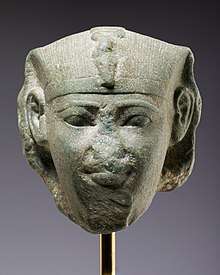
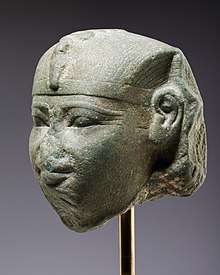
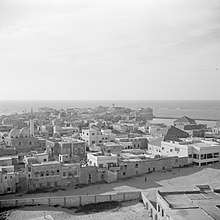
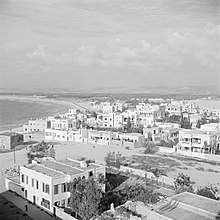
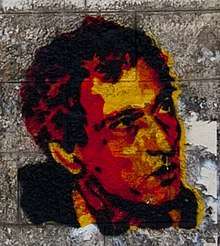

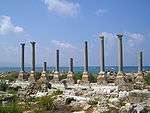



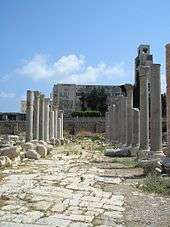












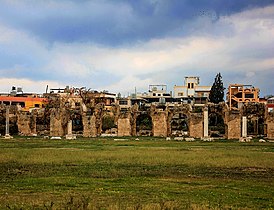


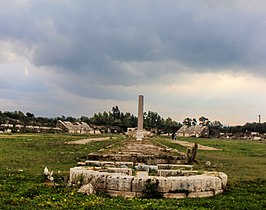



















































.jpg)


